There’s more to this stamp than meets the eye.
Starting around 1960, French copper cookware began carrying “Made in France” stamped into the copper. From what I can gather, this was due to country-of-origin labeling requirements for the European Economic Community (the precursor to the EU) formed in 1957. (Though this is hotly disputed!)
Some makers and stores had the word “France” already in their name or logo but others had to redesign their stamp or add a separate stamp to meet the labeling requirement. Sur La Table, for example, does not have the word France in its logo and so needed the additional origin marking on its imported copper. Mauviel, ramping up to mass production during this time, seems to have decided to stamp “Made in France” on everything, which may explain why pots stamped “Williams Sonoma France” sometimes have a separate, apparently superfluous, origin stamp.
Can these “Made in France” stamps be used to identify copper that is not stamped by its maker?
- Part 1 is a summary of my findings: the “Made in France” stamps I have observed, their key differentiating characteristics, and a few notes on usage.
- Part 2 is the evidence: photos of pans of known make with the corresponding Made in France stamp, and the same stamp on other unidentified pans that I think are by the same maker.
Part 1: Summary of findings
| Type | Notes | |
| One line, pre-1957 |  |
Appears on pans from late 19th and early 20th century imported into the US. |
| One line, post-1957 | 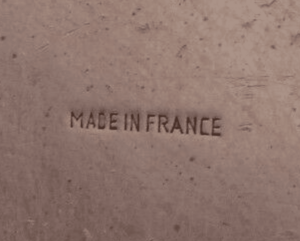 |
Most likely Mauviel, but possibly another Villedieu maker such as Havard. |
| Two-line, oval shape | 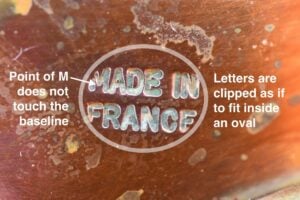 |
Appears with a Mauviel maker stamp. Possibly used later than the “short M” version below. |
| Two-line, rectangular shape, long M |  |
Almost certainly Mauviel or another Villedieu maker. |
| Two-line, rectangular shape, short M |  |
Appears on Mauviel and Atelier du Cuivre pans from the 1990s to early 2000s. |
| Three-line |  |
Appears with Atelier du Cuivre and L. Lecellier maker stamps. |
Part 2: The evidence
One-line, pre-1957
Reader Bryan P. has shared with me two examples of pots stamped for two New York cookware stores that are most likely late 19th to early 20th century. The pots themselves are almost certainly truly French in origin; it seems possible that the stores added the stamps to make clear that the copper was imported from France and therefore especially valuable.
The “Charles C. Ruegger” stamp dates the pot to sometime between 1874 and 1929 (after which he opened Bazar Français). The housewares store Lewis & Conger was founded in 1891 and seems to have operated into the 1950s (though I haven’t yet discovered its end date). Both of these date ranges suggest that the pots were stamped well before 1957.
I have two examples. The store stamps are different but the “Made in France” portion seems strikingly (no pun intended) similar. Note the curiously curled letter r in France — it is identical on each pot. My guess is the two stores were buying from the same importer.

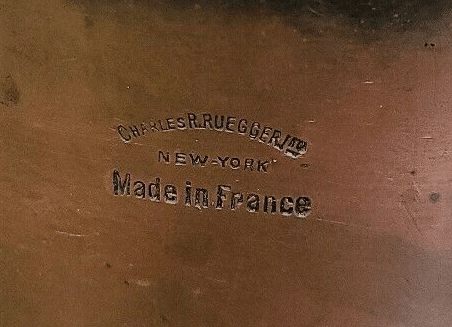
One-line, post-1957

There is also a one-line stamp that appears on pieces that are most likely produced after 1957.
Typographically, it’s most similar to the two-line “short M” version you will see below — the point of the M goes only halfway to the baseline. However, the letter C in this stamp is boxy-looking, while the “short M” version below has a rounded C.
Update: There may be a second one-line stamp without the boxy C — see below. So far I’ve seen it on a Havard-made piece.
Examples
Update: I think this stamp is Mauviel or another Villedieu maker. The “Gaillard Paris” and “E. DEHILLERIN PARIS” stamps of this era are store stamps, not maker’s marks; after WWII, these companies (along with Jacquotot) stopped making consumer-grade pots and pans to focus on the high-end restaurant market, and supplied Mauviel-made copper (or possibly other Villedieu makers) under their own name.

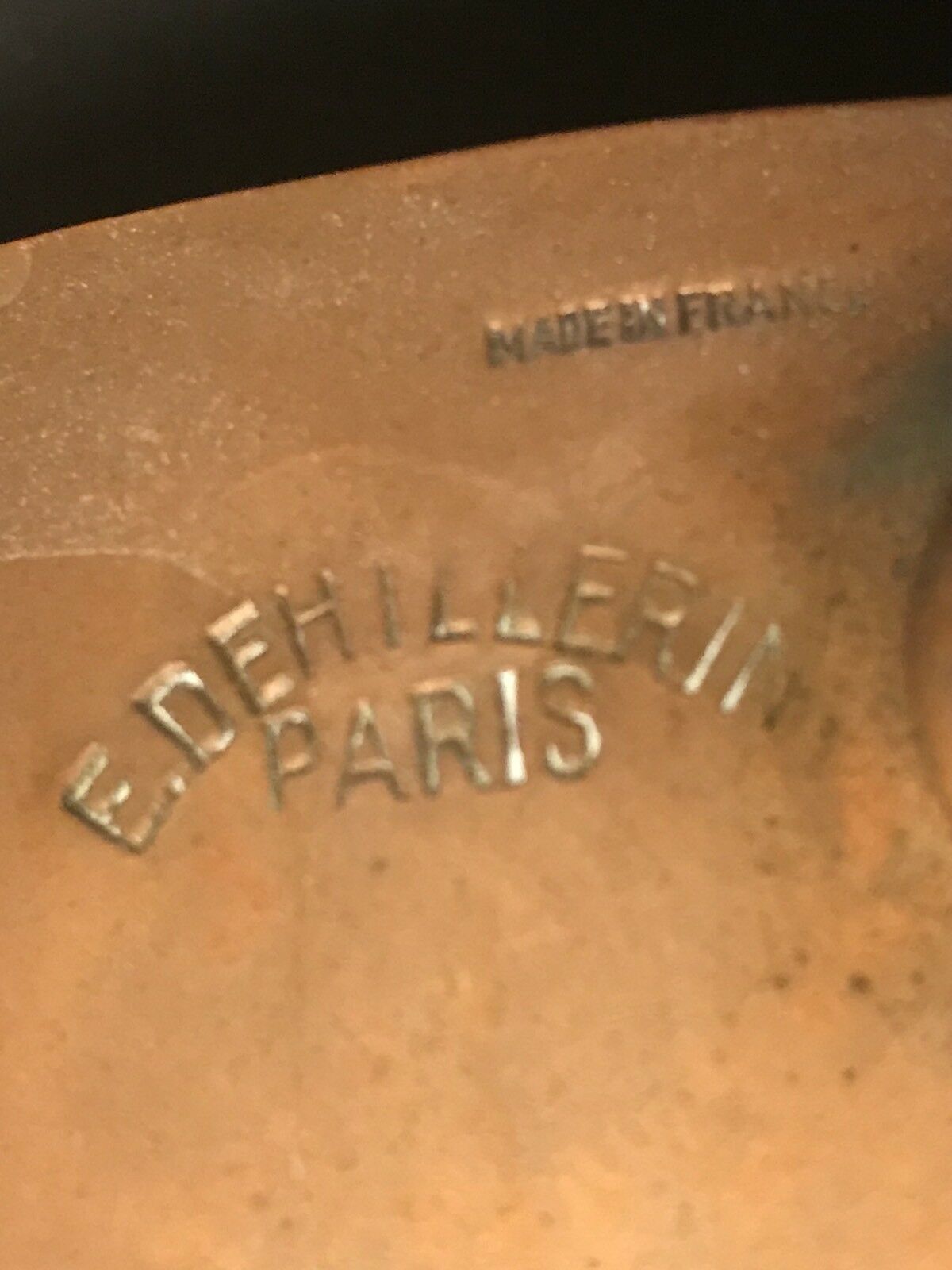


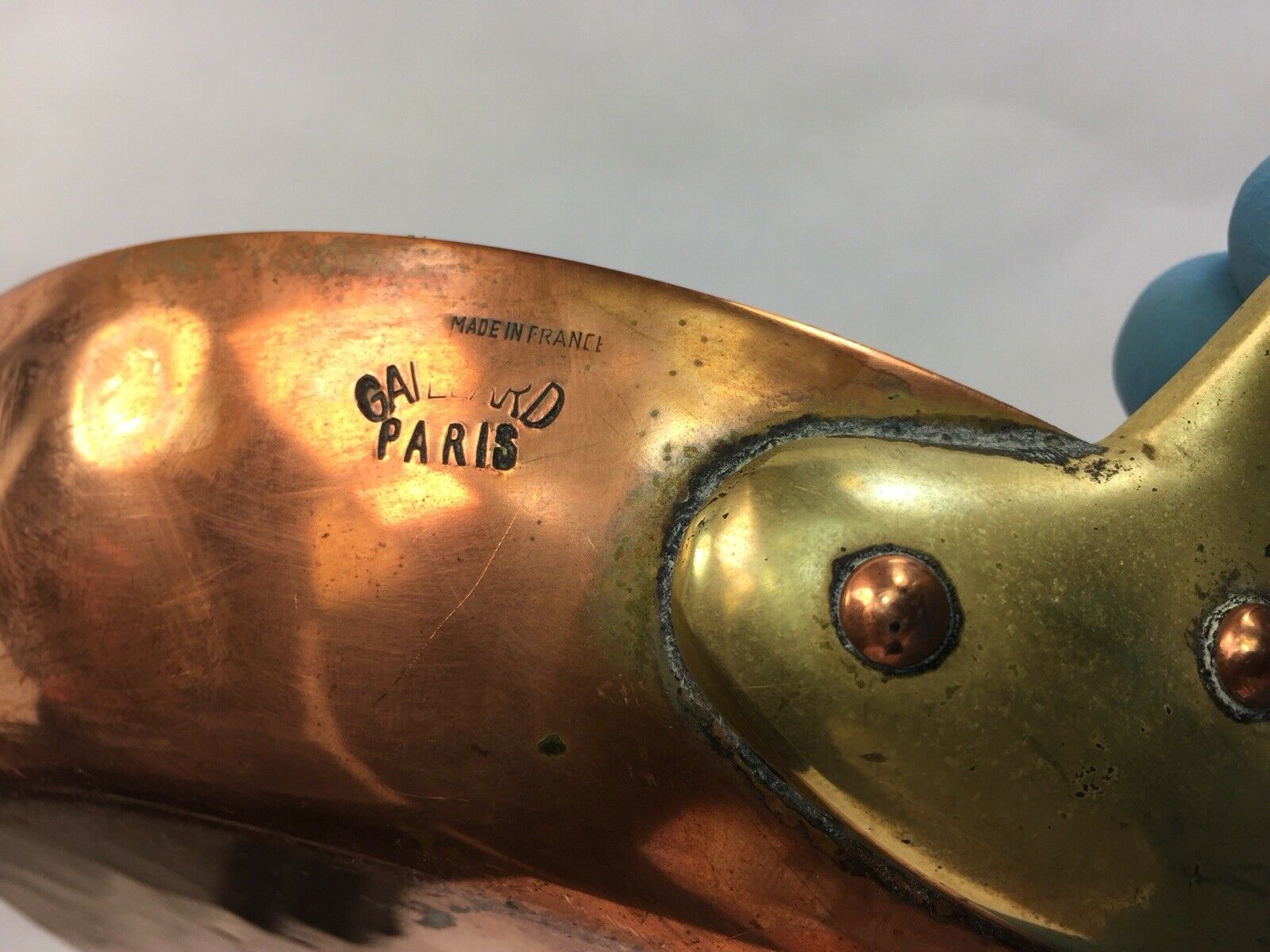
No store stamp
These are all definitely the same stamp — note the same boxy C.
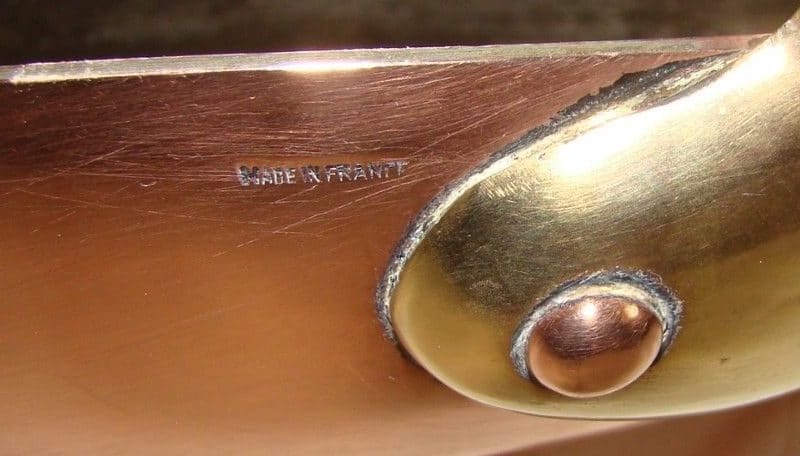
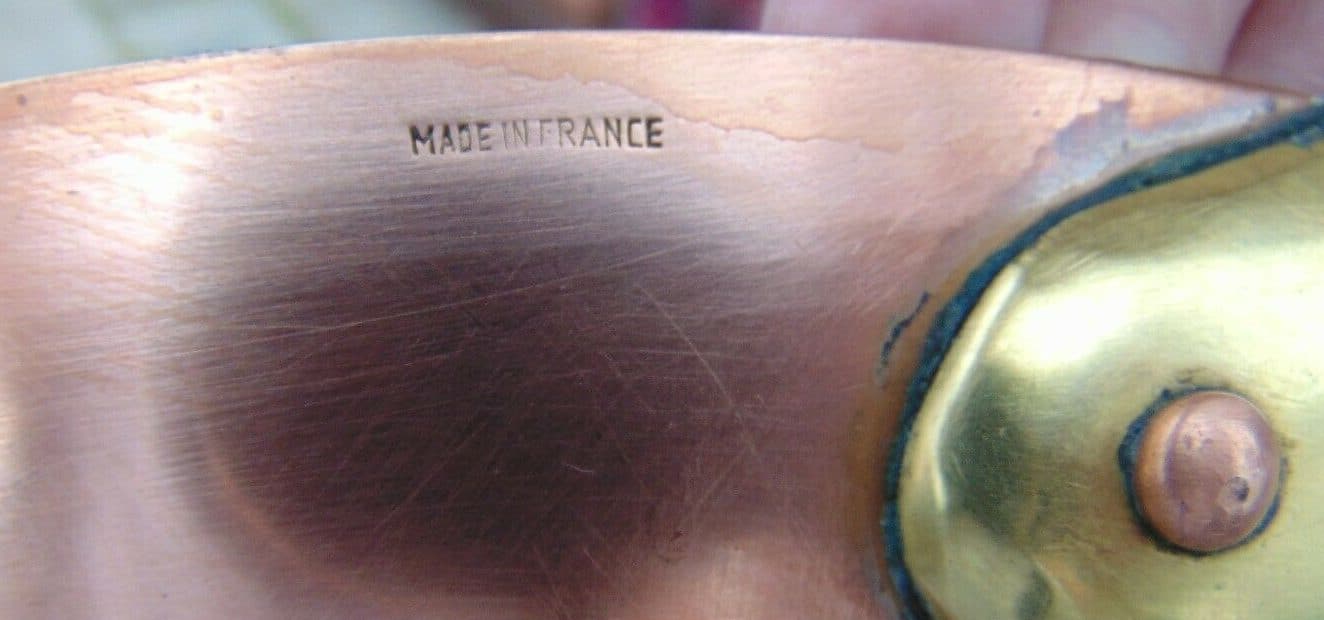

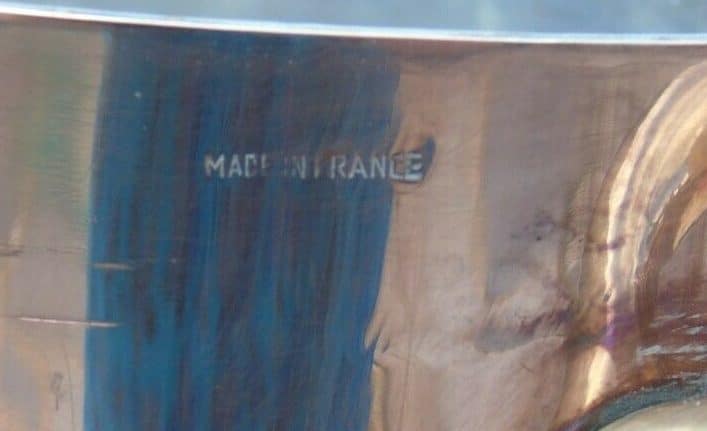

Update: I think there’s a second one-line stamp out there without the boxy C. I’ve seen it on the lid of a suspected Havard piece. I don’t have a the best quality photo of it, but here it is.
I’m going to keep an eye out for more examples.
 Two-line, oval shape
Two-line, oval shape
There are two distinctive characteristics of this stamp:
- Clipping/curvature of M, N, F, and E as though they were forced into an oval outline
- Point of M descends ¾ to the baseline but does not quite touch
The key thing about this stamp is that it looks as though it has been squeezed into an oval shape. Once you know to look for this effect, this stamp becomes easy to spot. Note, however, that copper stamps are sometimes applied with uneven force that can make some letters look thinned out, so try not to mistake a careless lopsided stamp for the true Mauviel rounded stamp. When in doubt, look for the point of the M: on this stamp, it does not quite touch the baseline.
Examples
With maker stamp
I have only seen this stamp style accompanied by a Mauviel stamp. My hypothesis is that these Mauviel stamps were put on items for sale at the Mauviel factory store in Villedieu-les-Poêles. Note that there are two Mauviel stamp styles in this series — one with an oval cartouche, and one without.

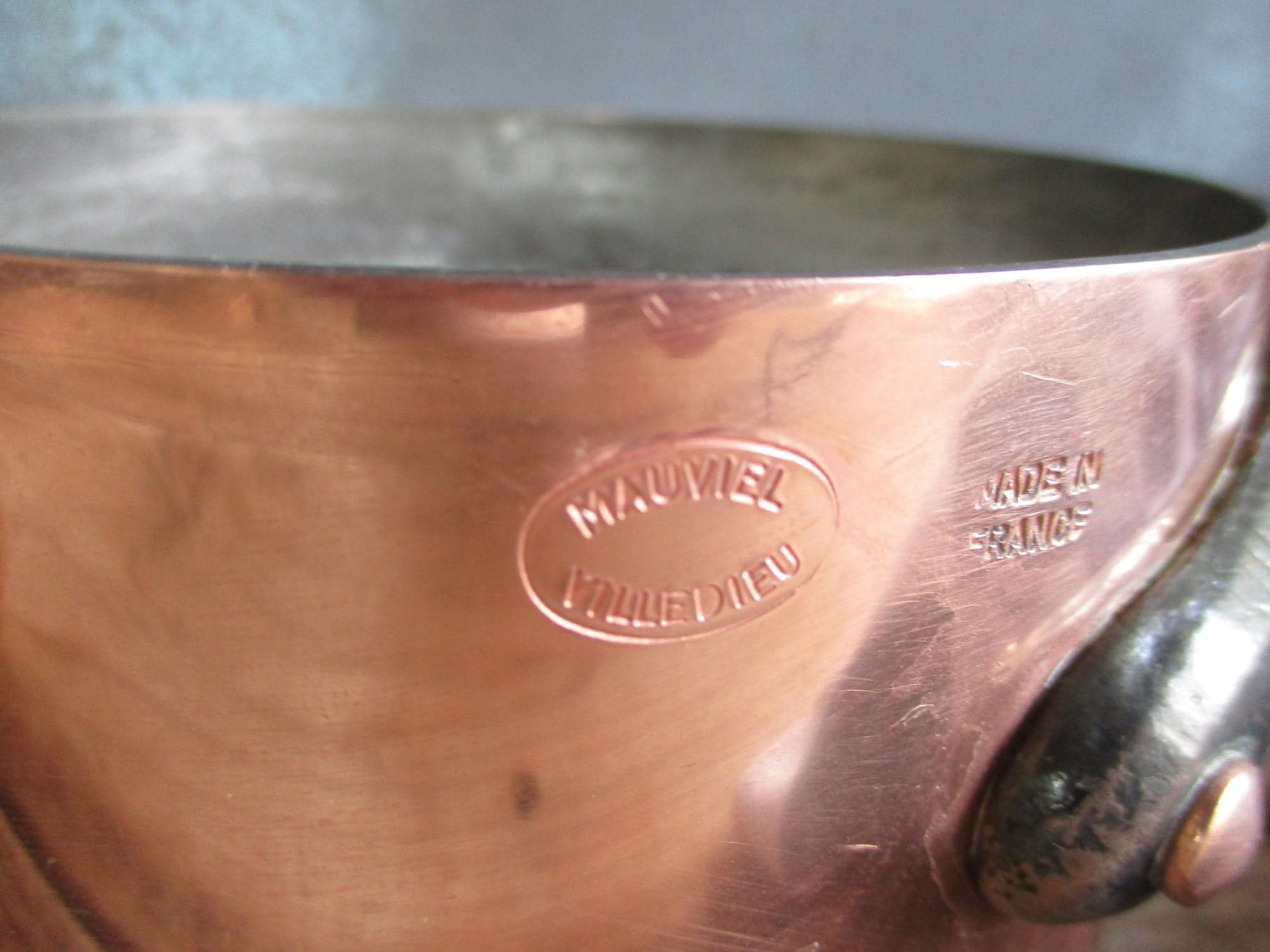
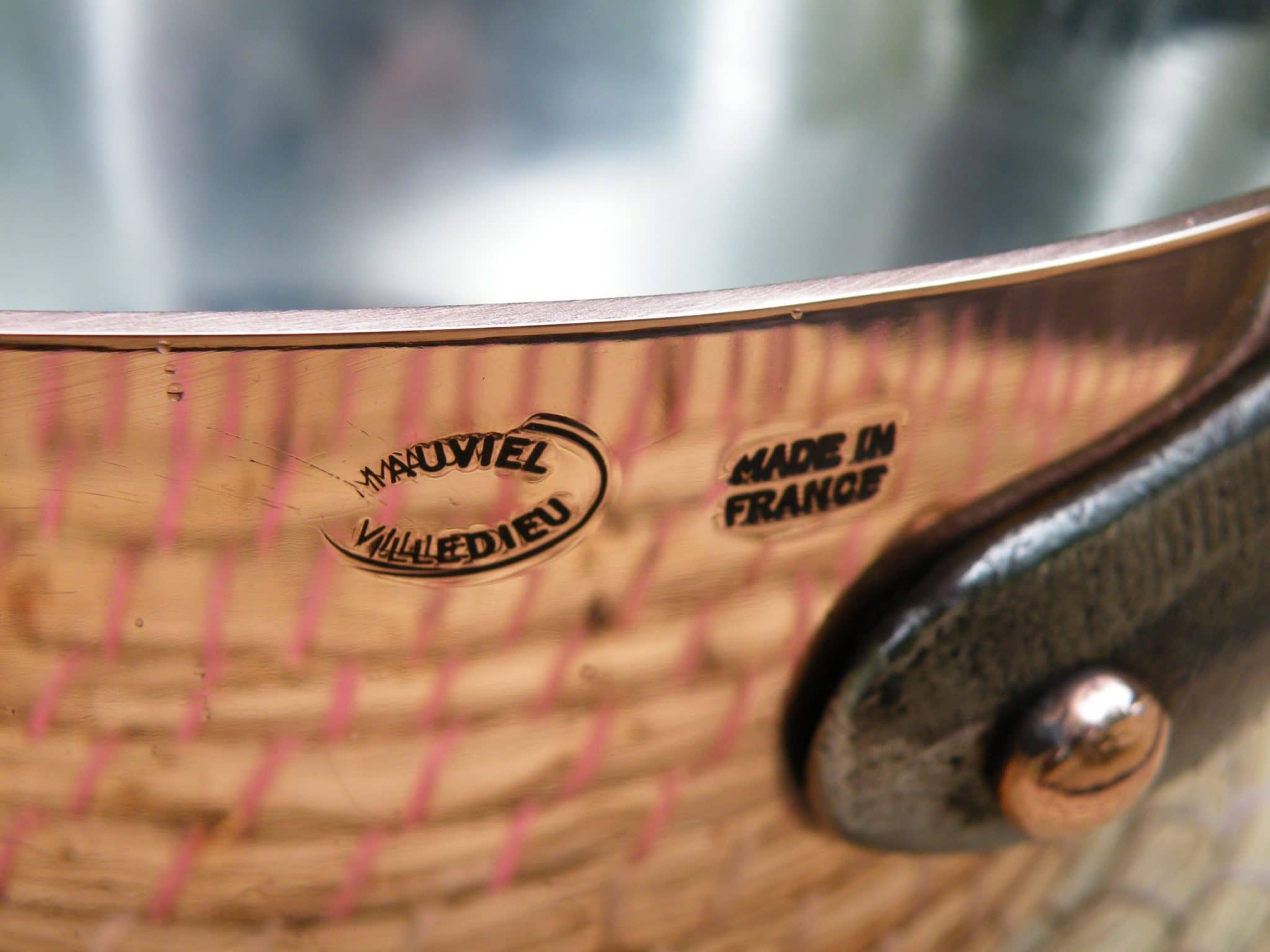


With store stamp
This group of store stamps tells me a few things. First, the oval Crate and Barrel, Dehillerin, and Verbeelen store stamps look very similar to the oval Mauviel Villedieu stamp above; this leads me to wonder if the Mauviel factory had the store stamps made up in the same style as its own maker stamp at the time.
Second, the Sur La Table store stamp is the current Sur La Table logo, not the “SLT” monogram version that I suspect is older. This would date use of this stamp to later than the two-line short-M version you will see below.
Finally, I’ve noticed that the brass handles in use in this series all have rounded baseplates. Compare them to the spade-shaped baseplates in the rectangular version below. (Absence of evidence is not evidence of absence, of course, as I will keep an eye out for other examples to disprove this.)


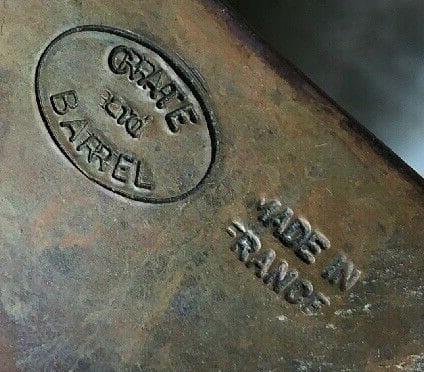
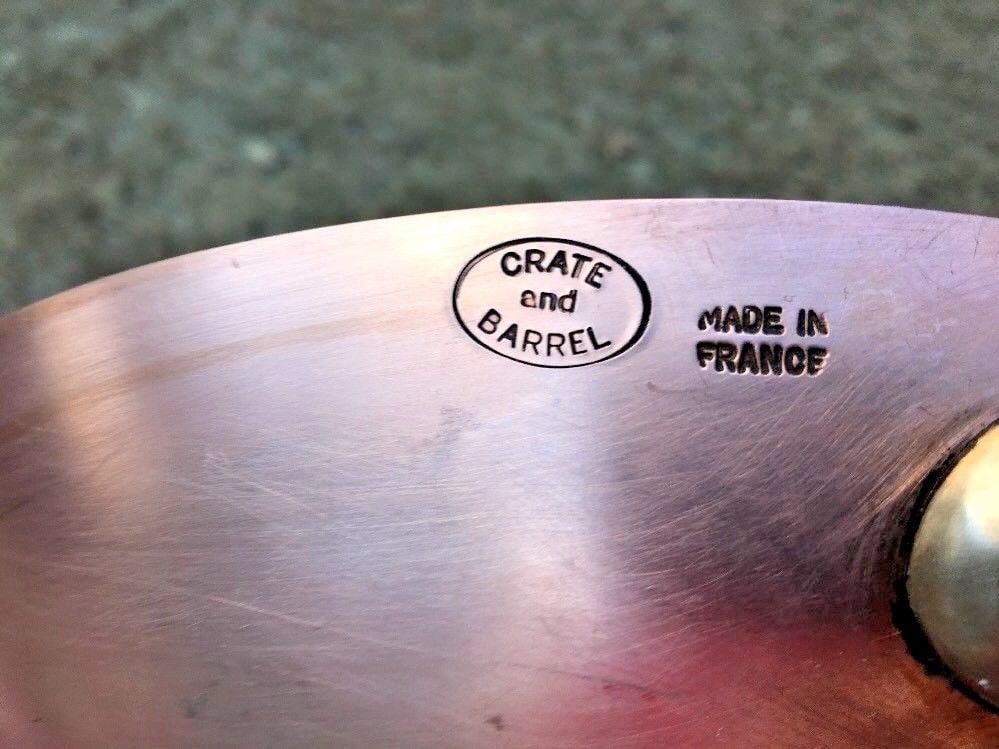



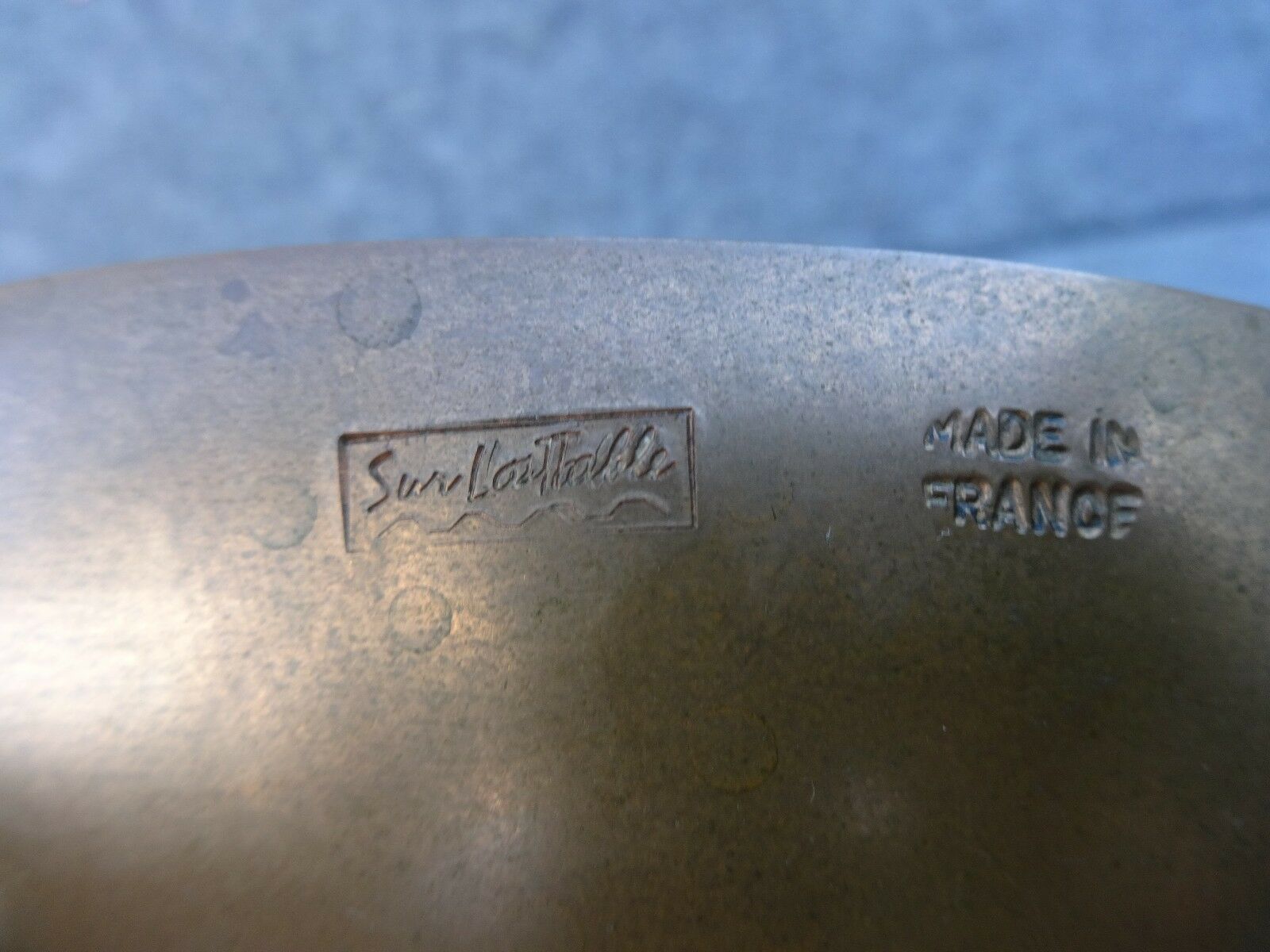

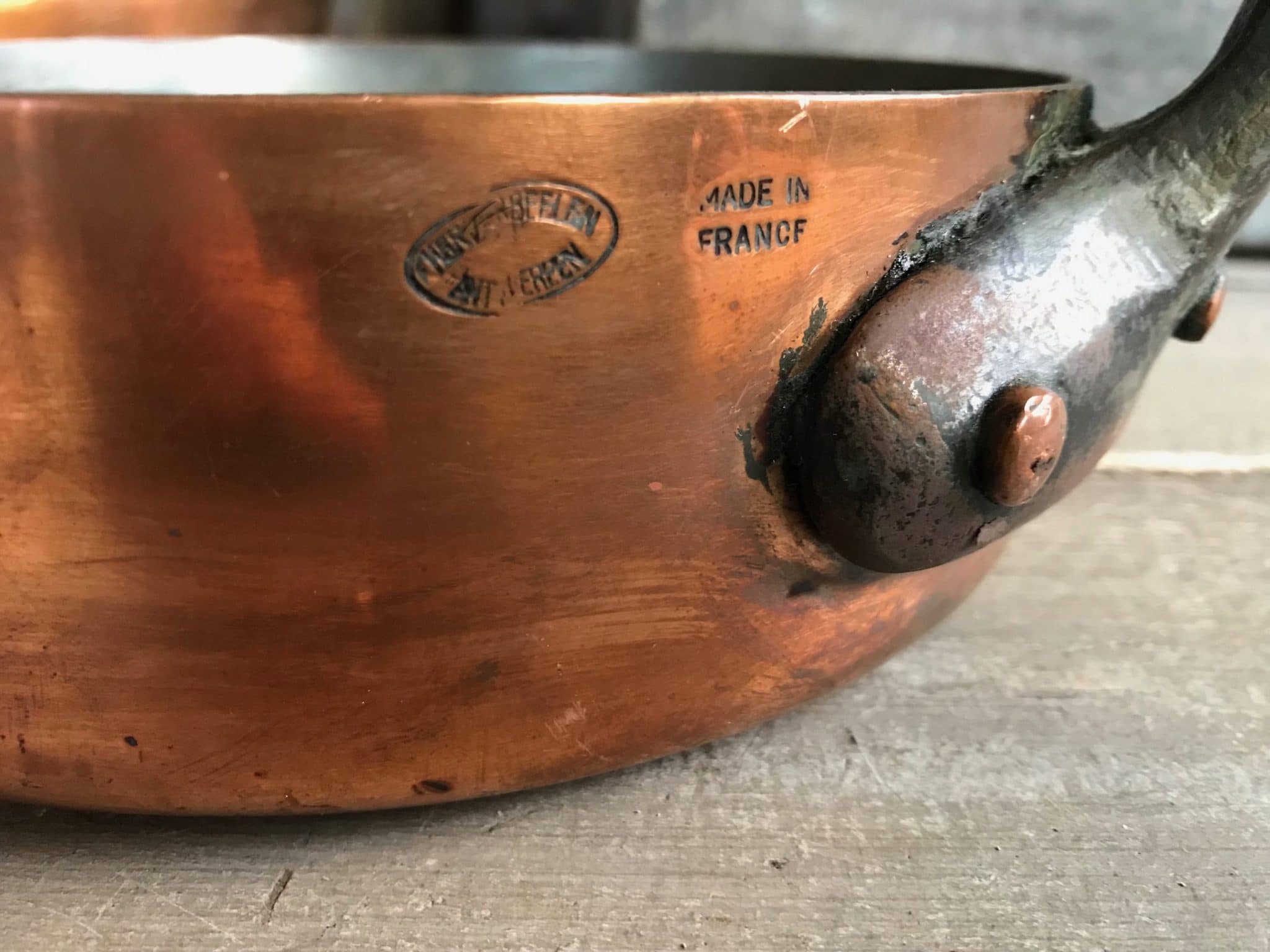

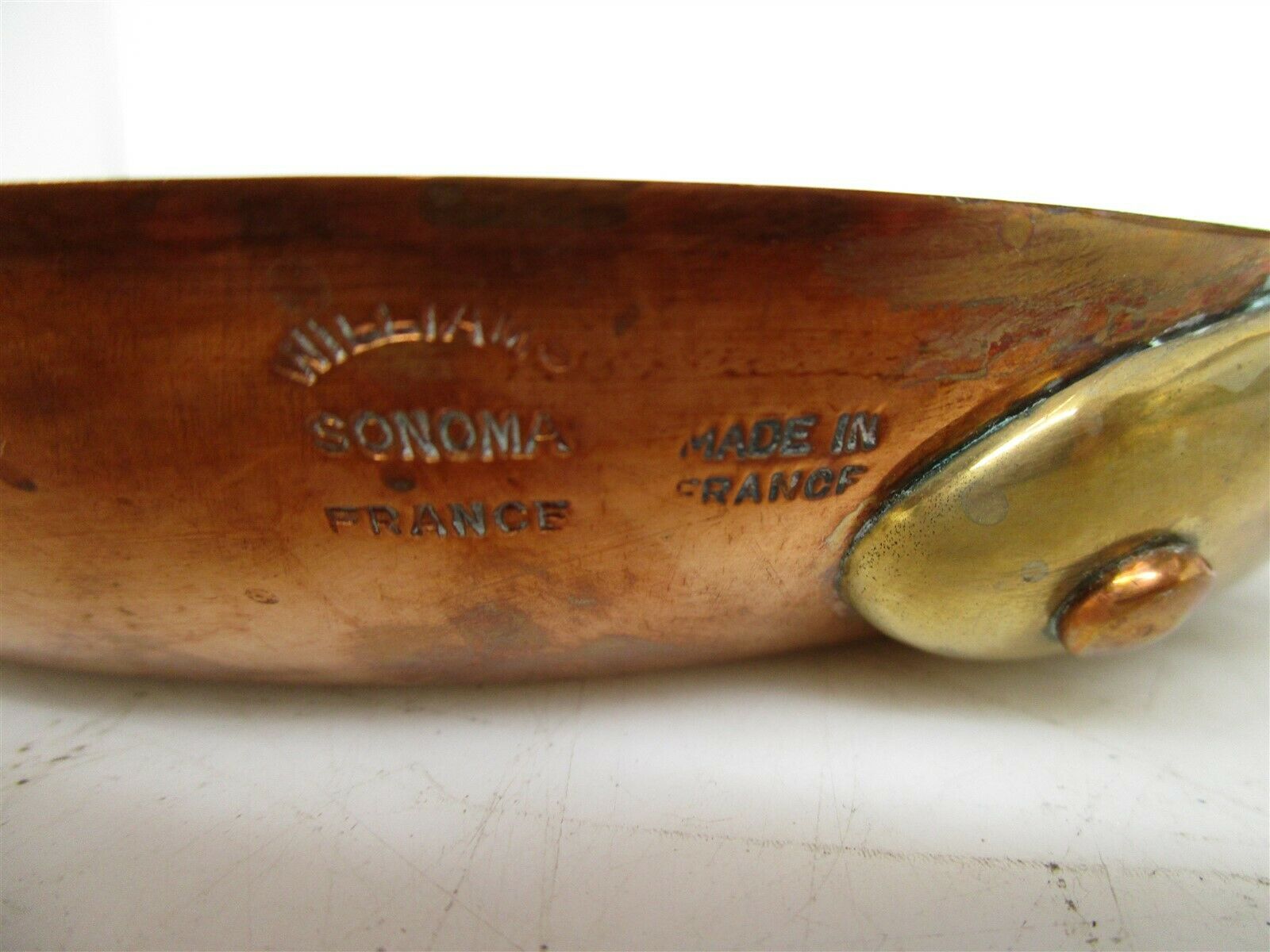
No maker or store stamp


 Two-line, rectangular shape, long M
Two-line, rectangular shape, long M
This stamp is easy to confuse with the oval shape version, so here are the key things to look for.
- No exterior clipping of letters
- Point of the M touches the baseline
The challenge is that these stamps are often applied with unequal force, so one side of the stamp can be deeper than the other, or the outer edges can appear faint. A mis-applied stamp can make the vertical strokes of the M, N, and F fade away, which might make you think it’s the oval version above. When in doubt, look at the M: in this stamp, the center point of the M touches the baseline (“long M”), which is a key difference from the oval version.
Examples
Update: I believe this stamp identifies Mauviel-made pieces. Even though it can appear alongside marks for Dehillerin, Jacquotot, or Gaillard, these companies had stopped making consumer-grade copper after WWII to focus on the restaurant and catering market. If a customer wanted smaller pots and pans, these companies turned to Mauviel (or perhaps another Villedieu maker) and stamped their name on it — just as if they were a store.
All five of my daily-use 1980s-era Gaillard saucepans carry this stamp. I’m including all five of them to give you a good overview of variations in the appearance of the same stamp across multiple pans. Reader Stephen Whalen has also contributed a photo of this stamp on a Jacquotot pan with the 77 Rue Damesme address (its location after WWII).


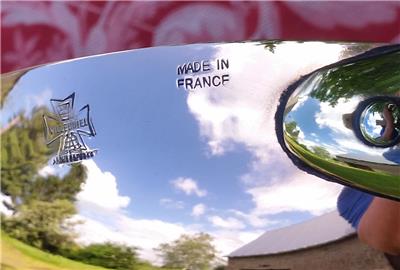


With store stamp
I see some patterns in the manufacture of these pieces. Some of the brass-handled saucepans have a distinctive spade-shaped baseplate, while the shallow skillets use a rounded version. I don’t know yet whether these differences signify different sources in Villedieu — Mauviel versus Havard versus Atelier du Cuivre versus Lecellier and so forth.


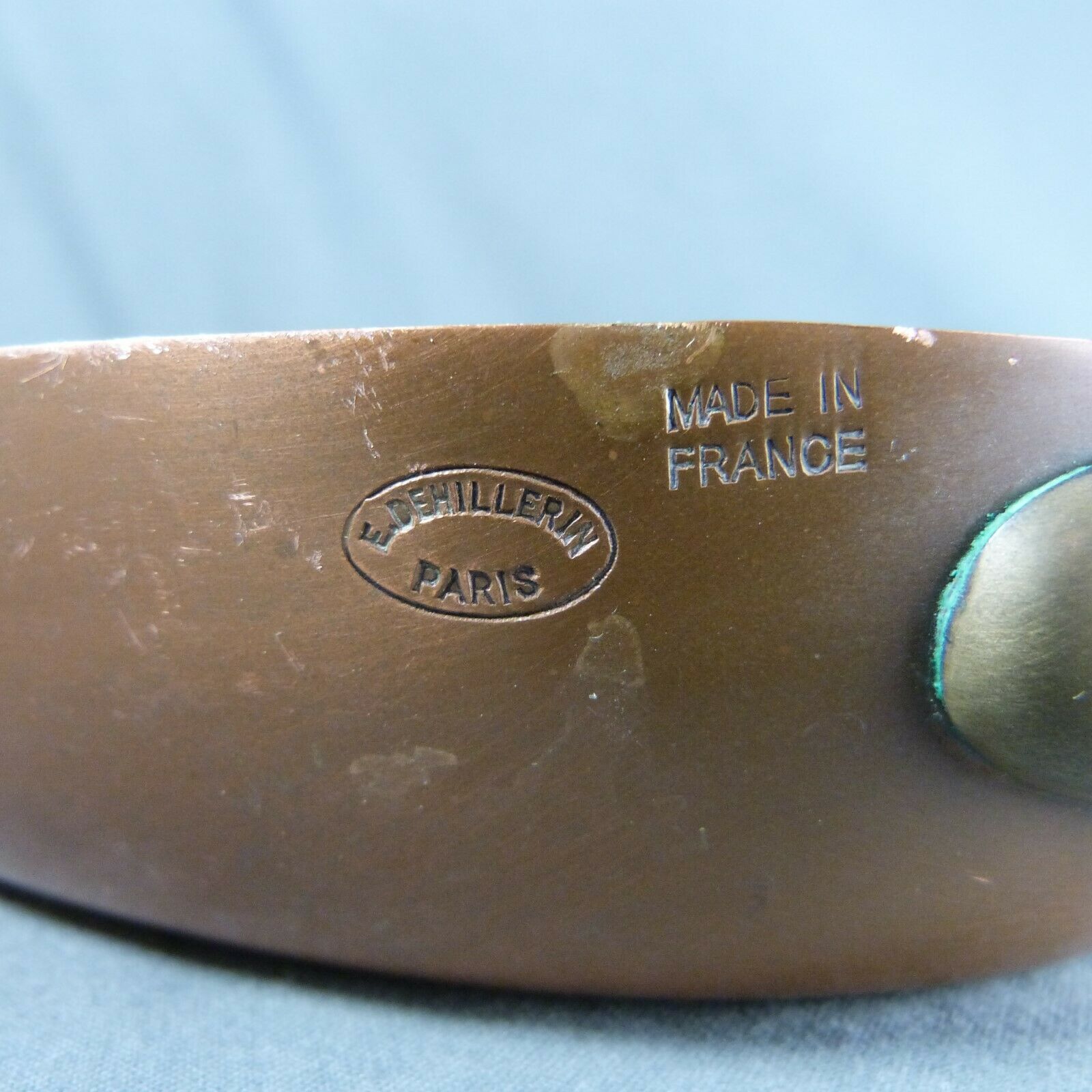

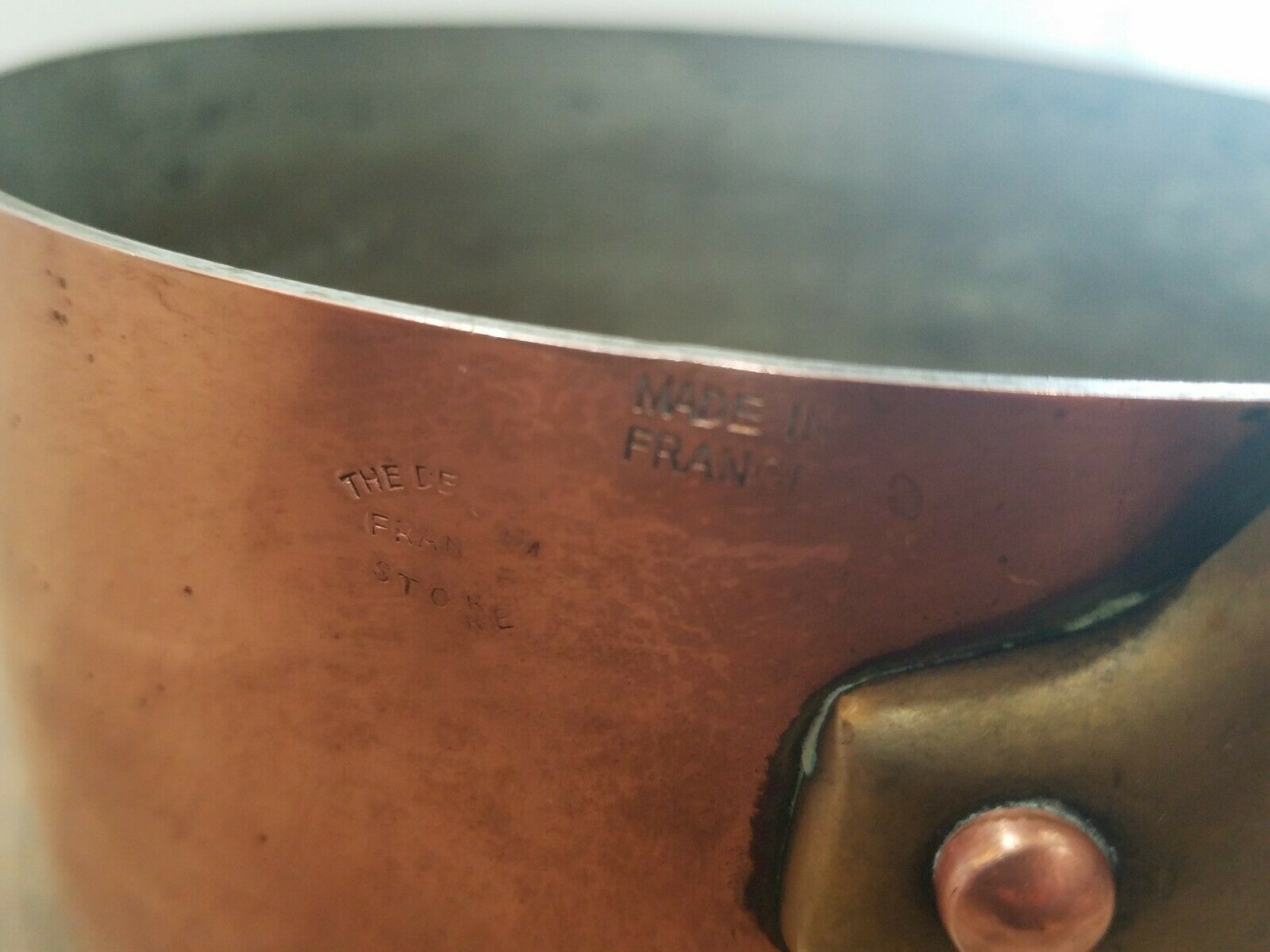
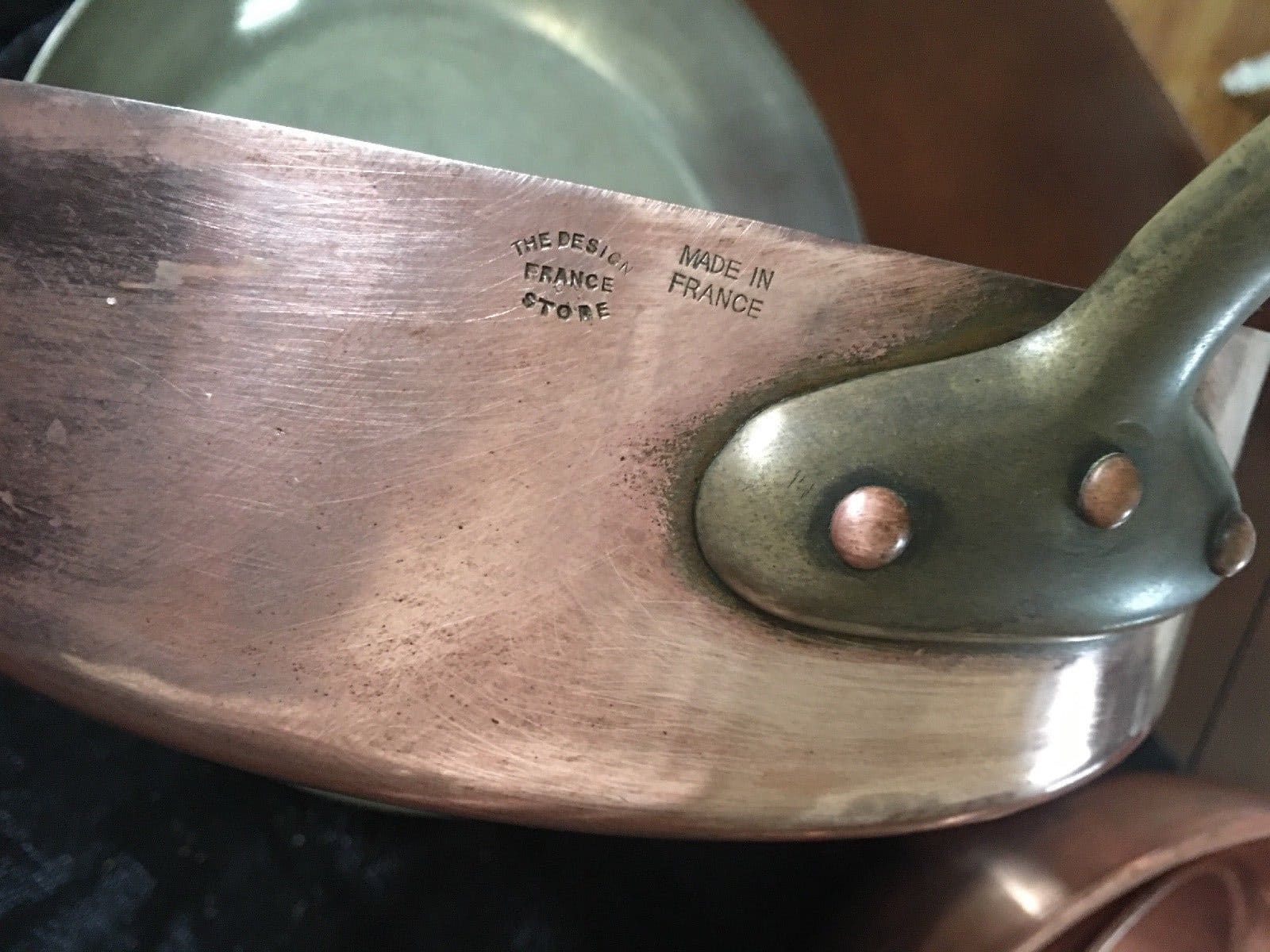


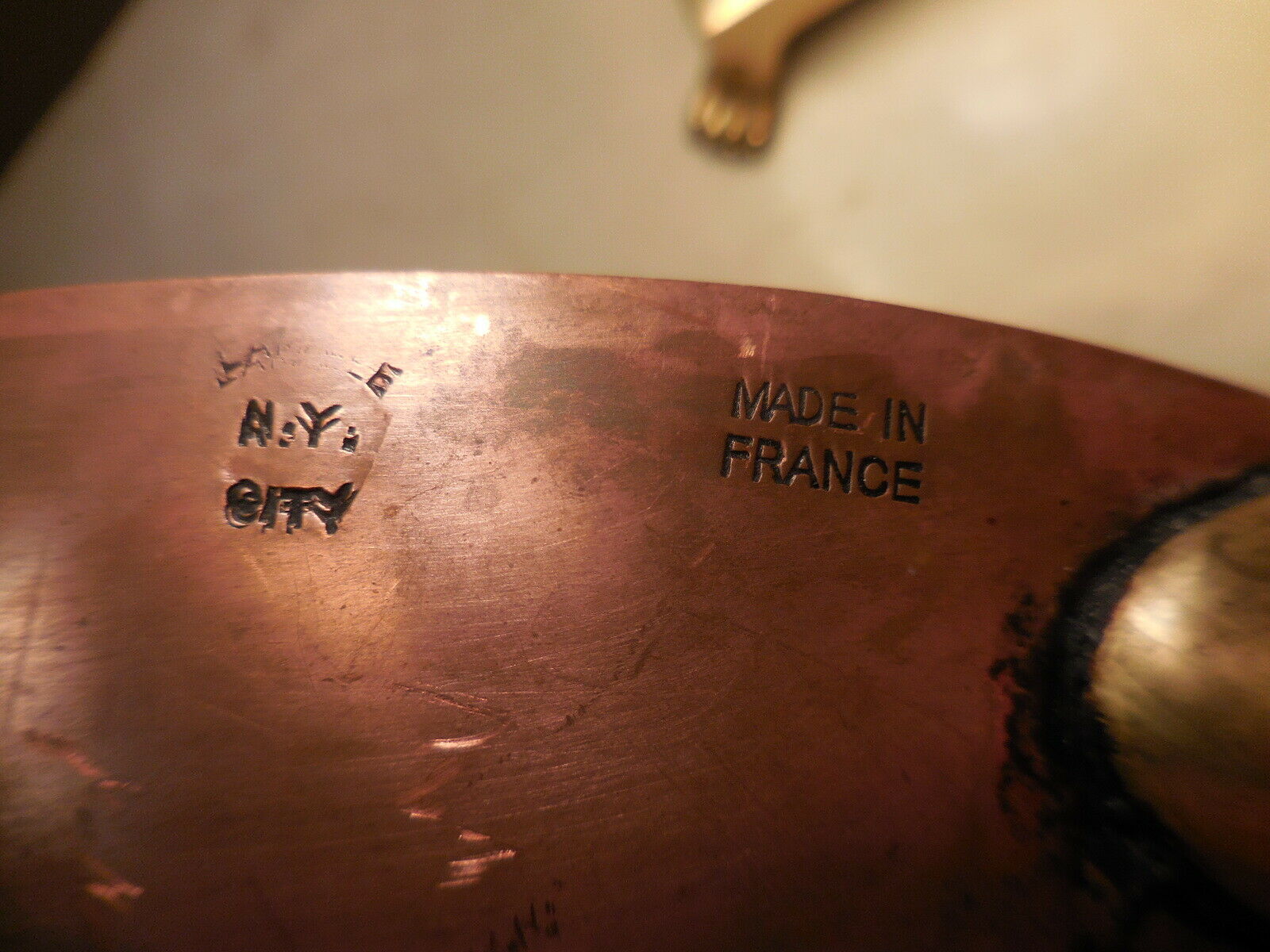
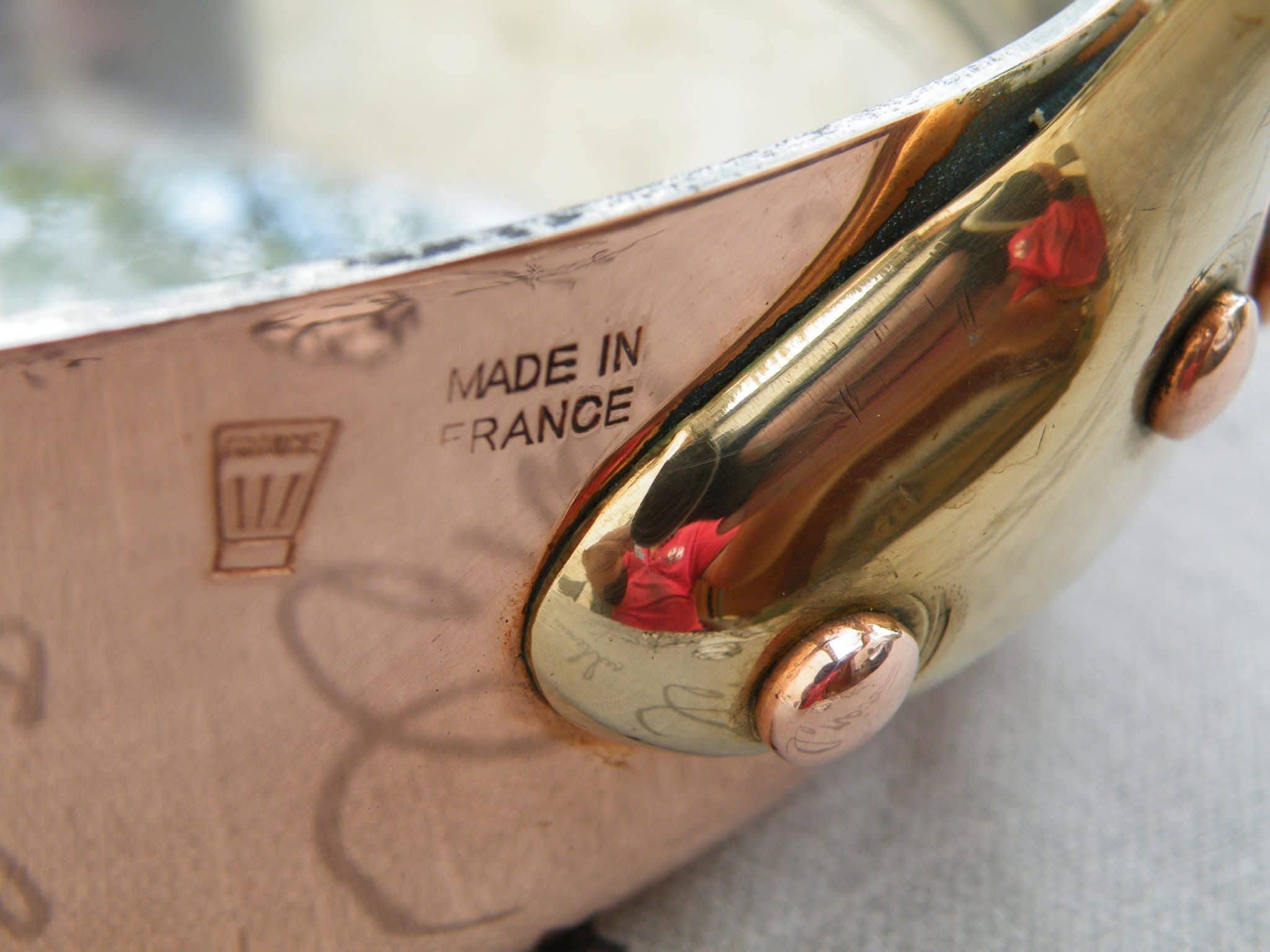

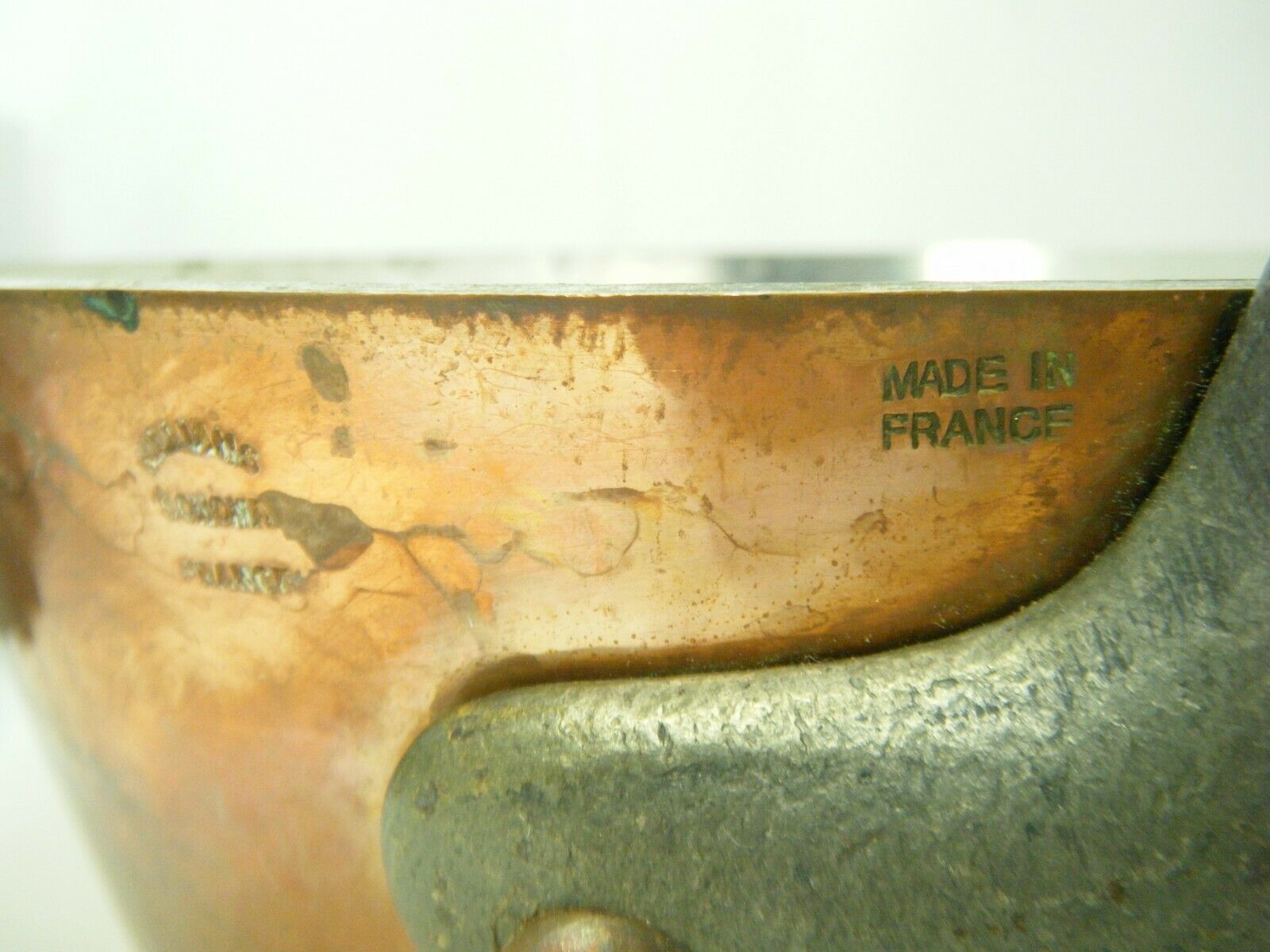
No maker or store stamp
As above, I see more spade-shaped brass baseplates on the saucepans in this set, while the skillets have rounded baseplates.
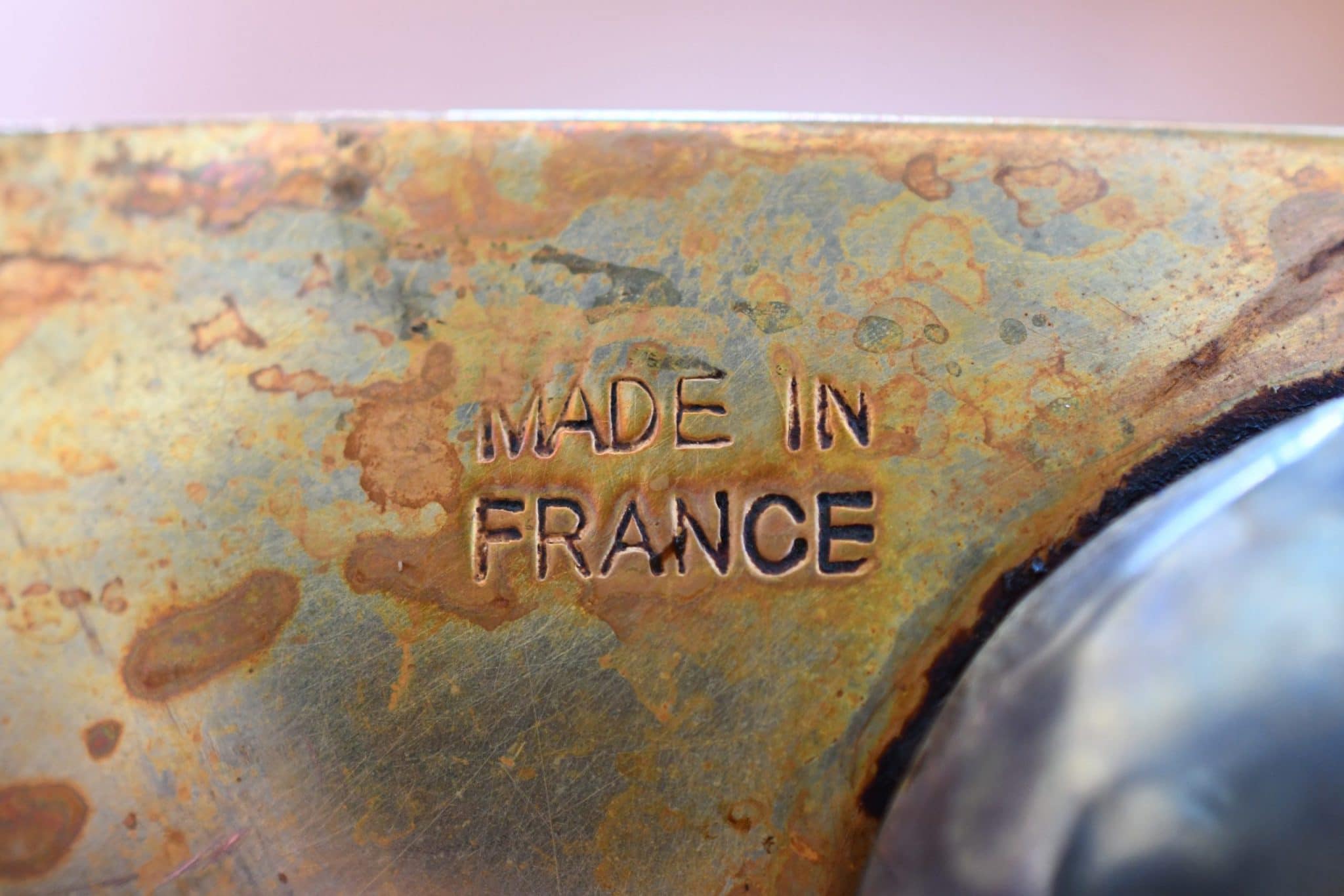
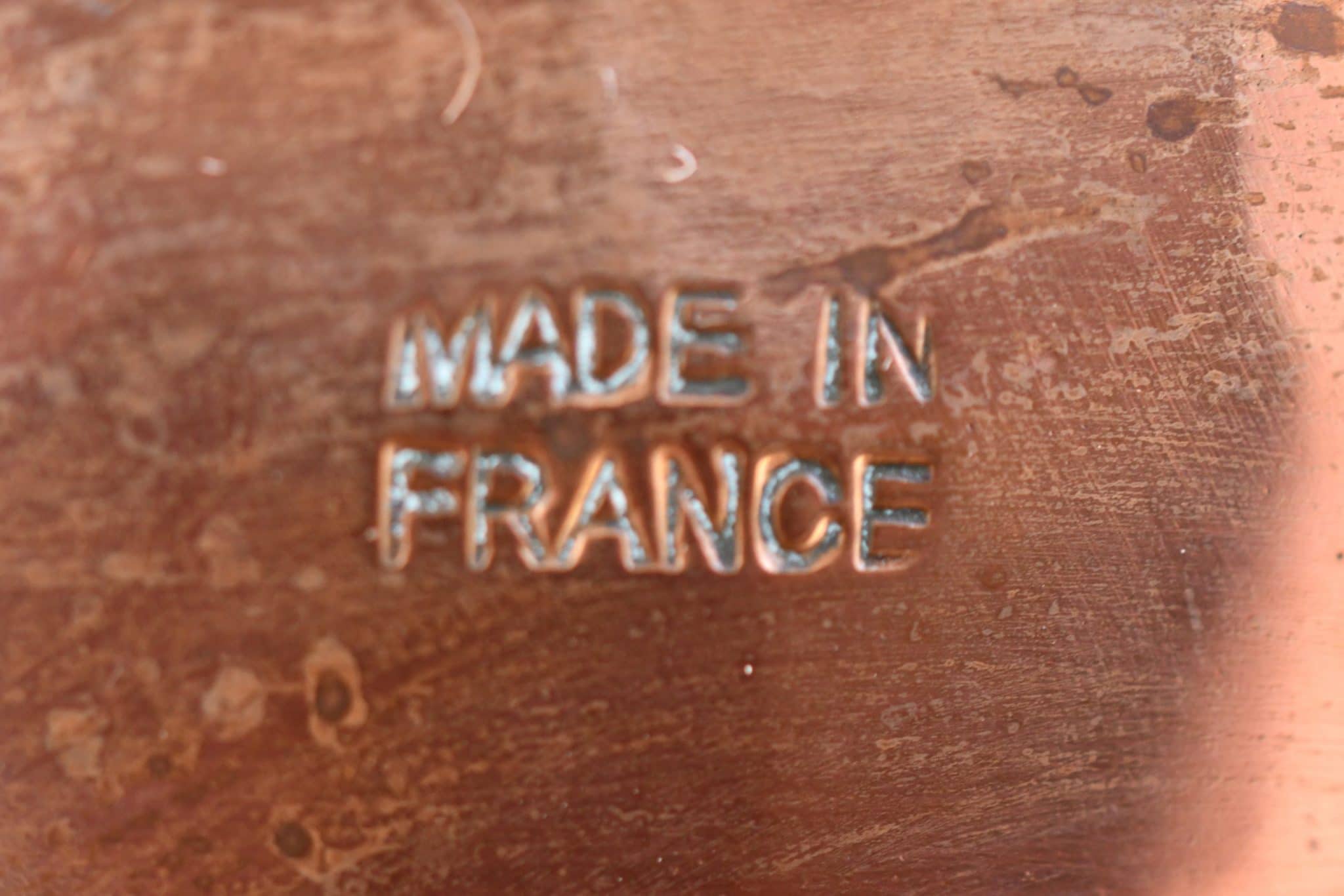

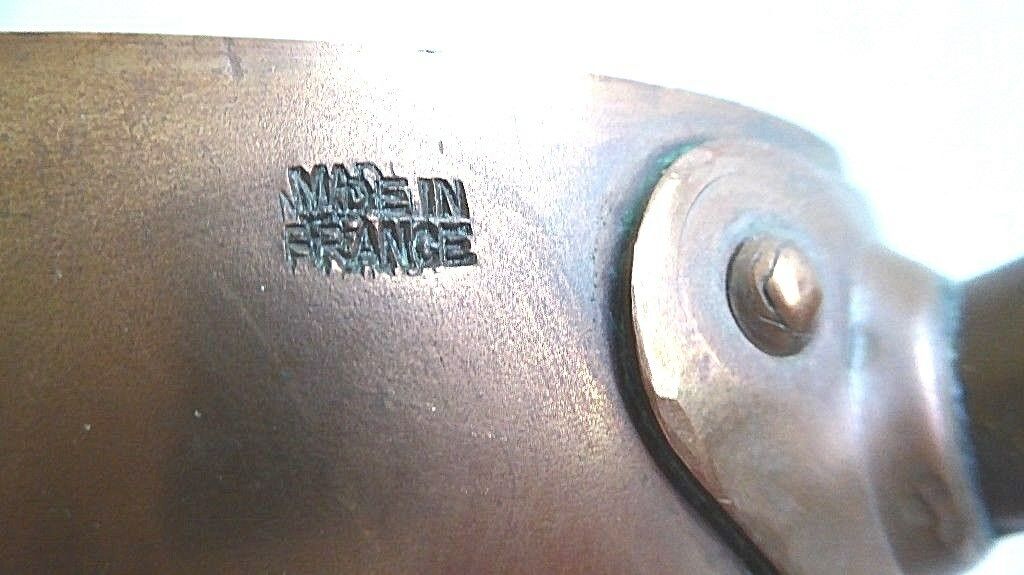


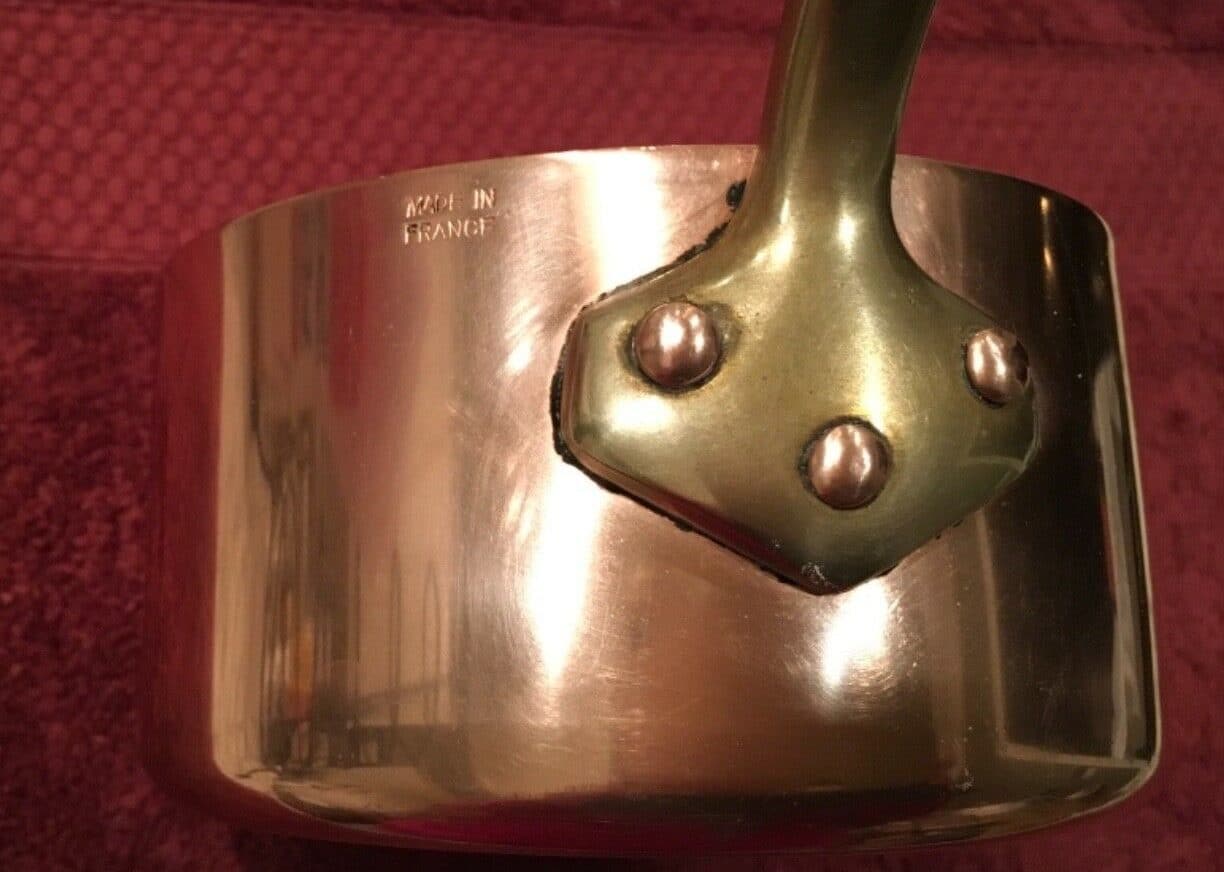
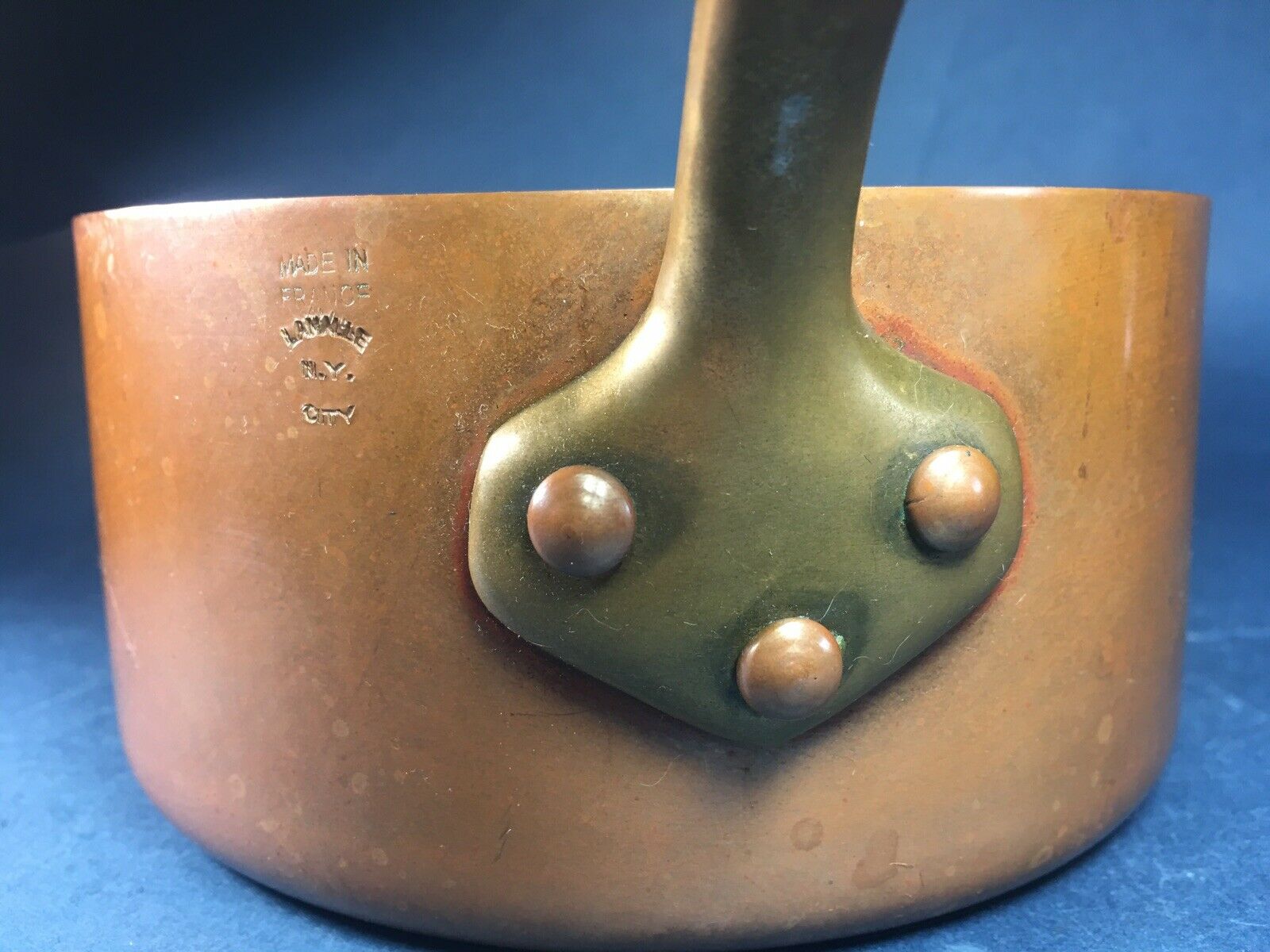




Two-line, rectangular shape, short M
It can be tough to tell this one from the other two-line rectangular versions, so look closely for its distinctive characteristics:
- Rectangular with no exterior clipping/curvature of letters
- Point of the M descends ½ of the way to the baseline
This stamp can appear quite different on different pans: on some the stamp is deep and the letters are substantial, while on others the stamp was applied with less force and the letters look thin, almost engraved rather than impressed. This puzzled me for quite some time until I realized something that should be obvious: I see the thin style on stainless-steel lined pans, and the thicker style on tinned pans. I think these are identical sister stamps but applied with different force according to the material of the pan wall.
Appearance on steel-lined pan
|
Appearance on tin-lined pan
|
I see this stamp on tin-lined and steel-lined pieces stamped for Mauviel and Atelier du Cuivre. My theory is that Atelier du Cuivre was buying unfinished pot bodies from Mauviel and finishing them with their own handles and stamp. Take a look and let me know what you think in the comments.
Examples
Steel-lined pans with store stamp
These two pans have store stamps: one for Sur La Table, and the other for Queen Anne Thriftway, a chain of grocery stores in the Seattle area of Washington state. (Queen Anne Thriftway changed its name to Metropolitan Market in 2003.) The older version of the Sur La Table insignia and the window of time for the “Queen Anne Thriftway” name suggest to me that these are 1990s to early 2000s.

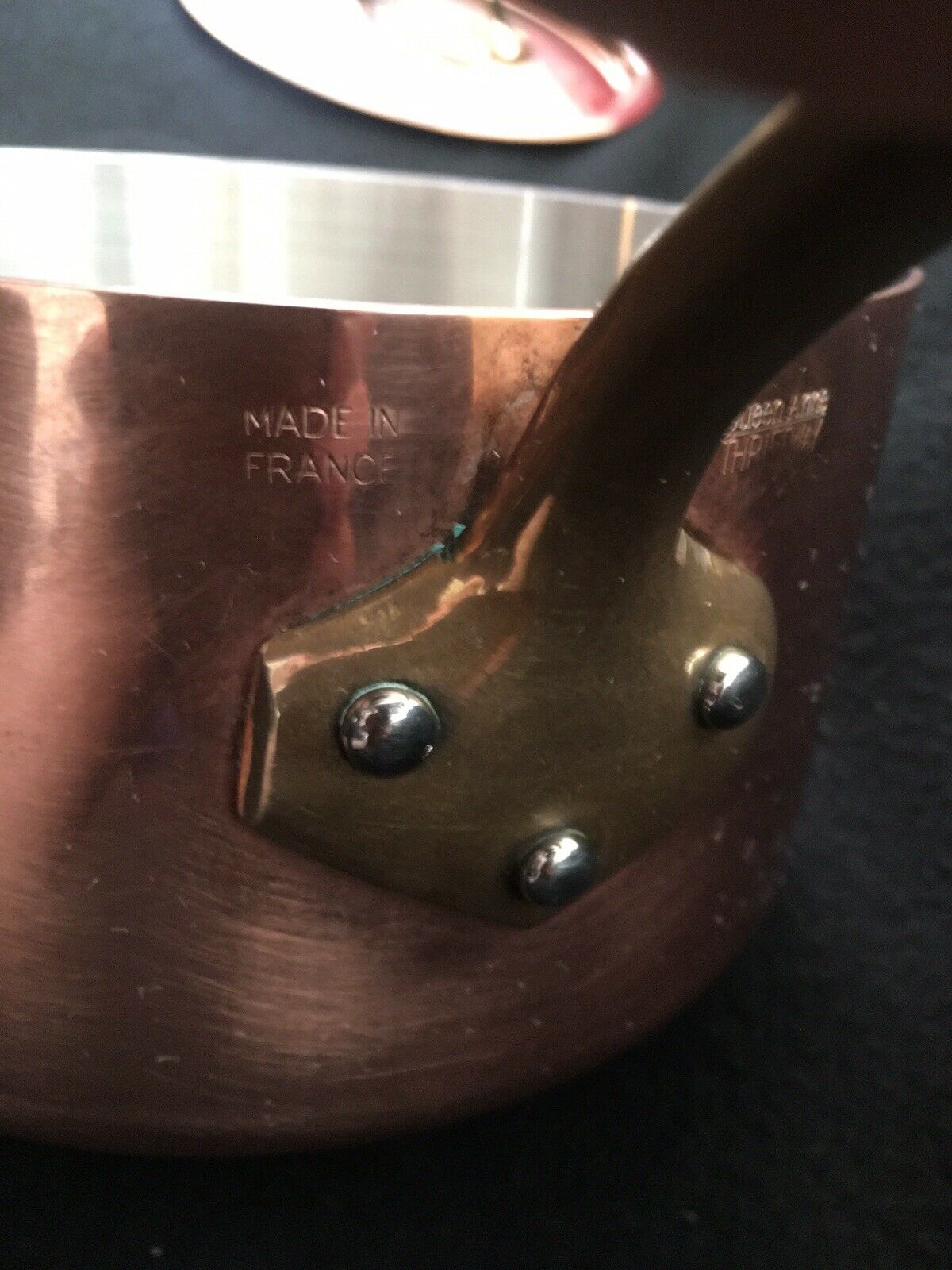
Steel-lined pans with no maker or store stamp
If my theory is correct, these are steel-lined pans that were finished by Mauviel or Atelier du Cuivre but not given maker’s marks.

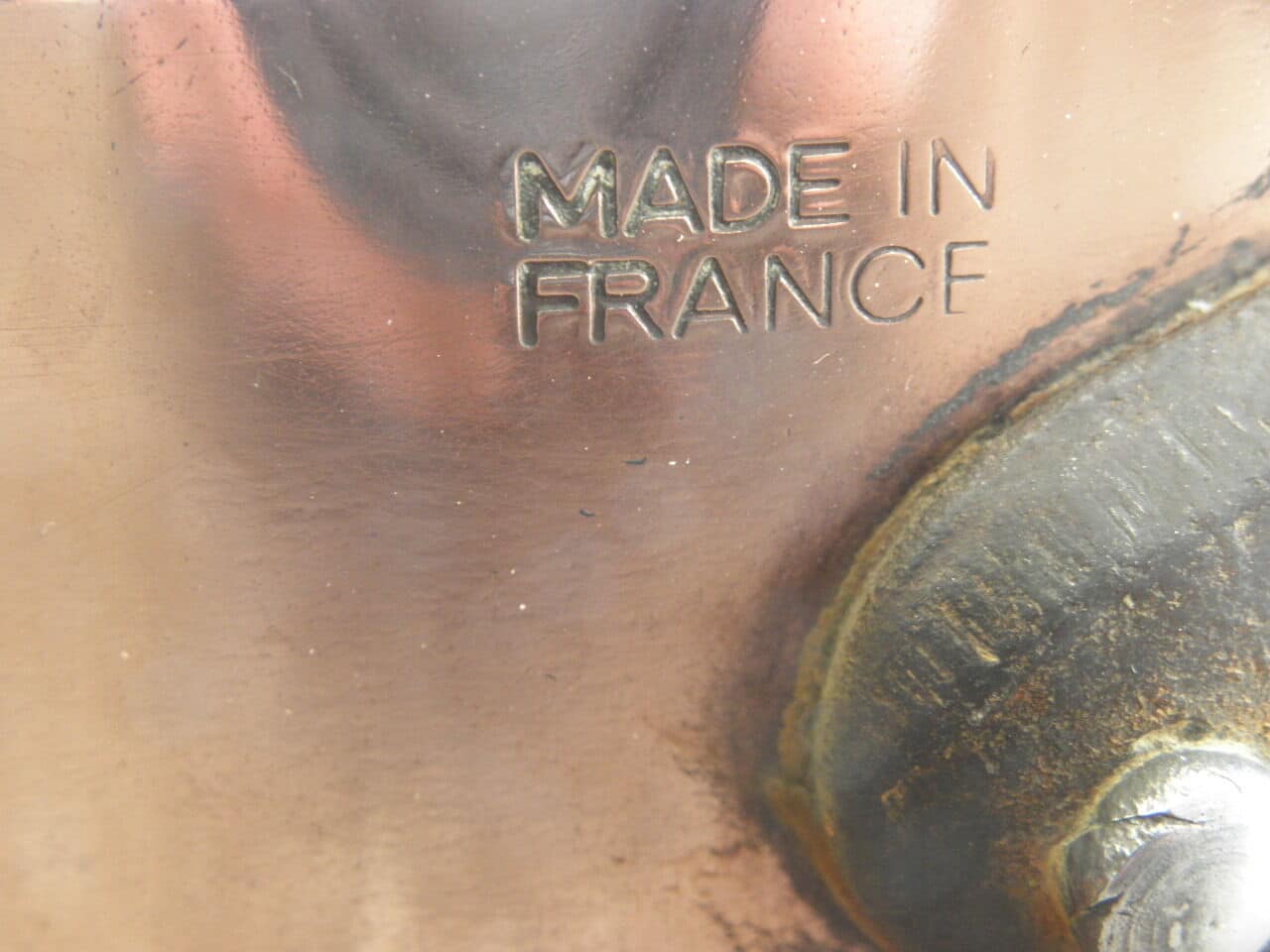


Tin-lined pans with maker stamp
These examples are stamped for Mauviel or Atelier du Cuivre.
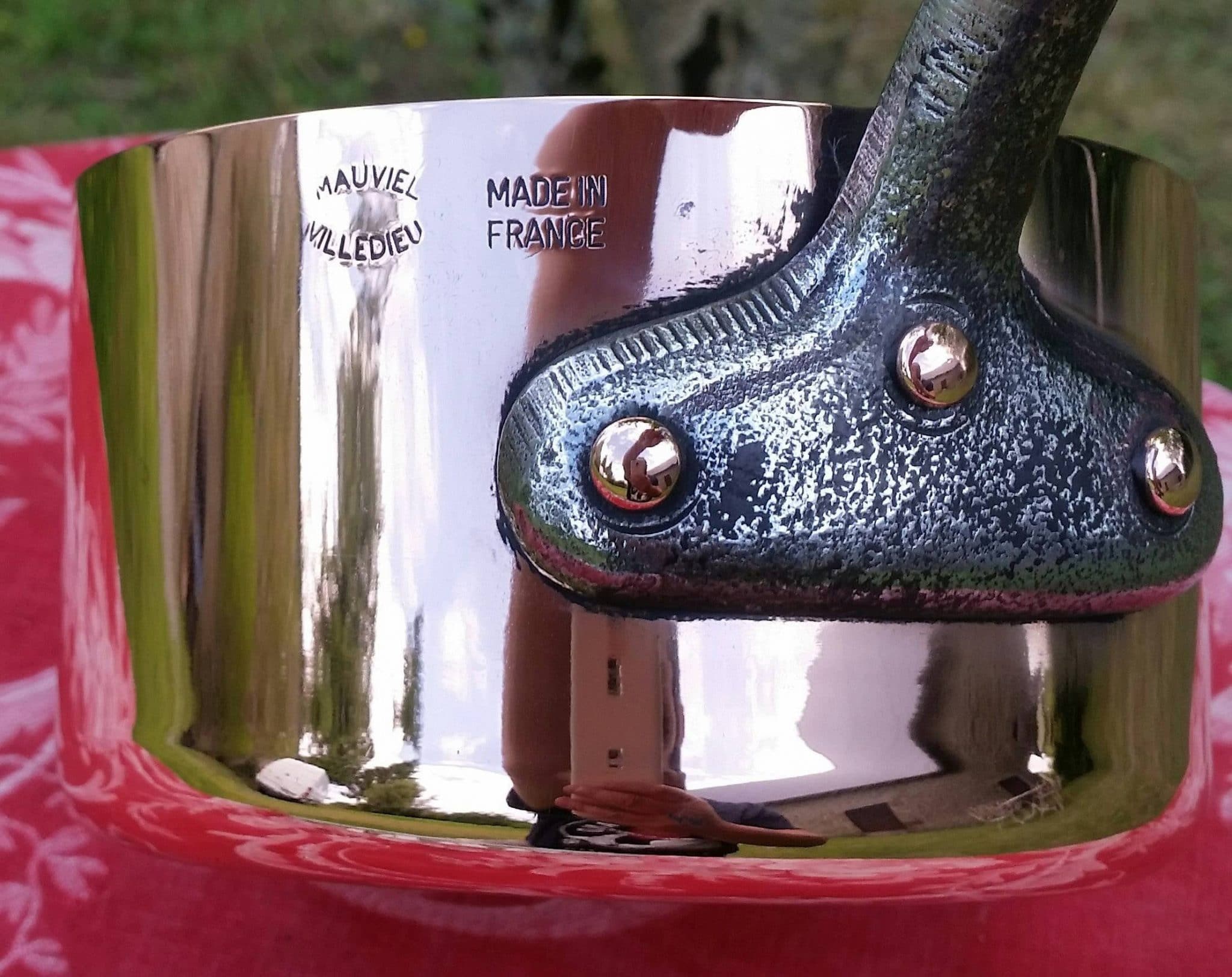


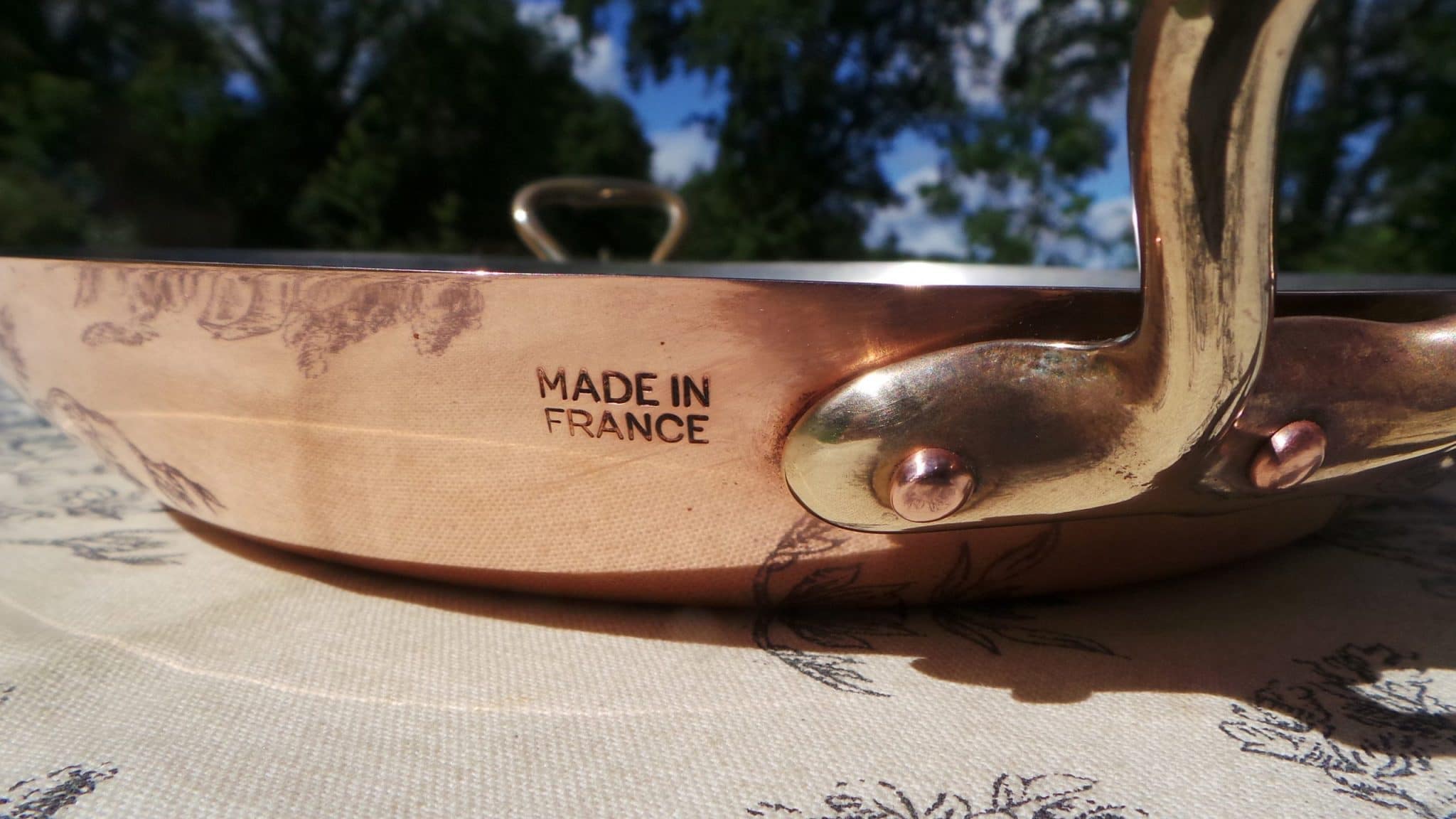
Tin-lined pans with no maker or store stamp
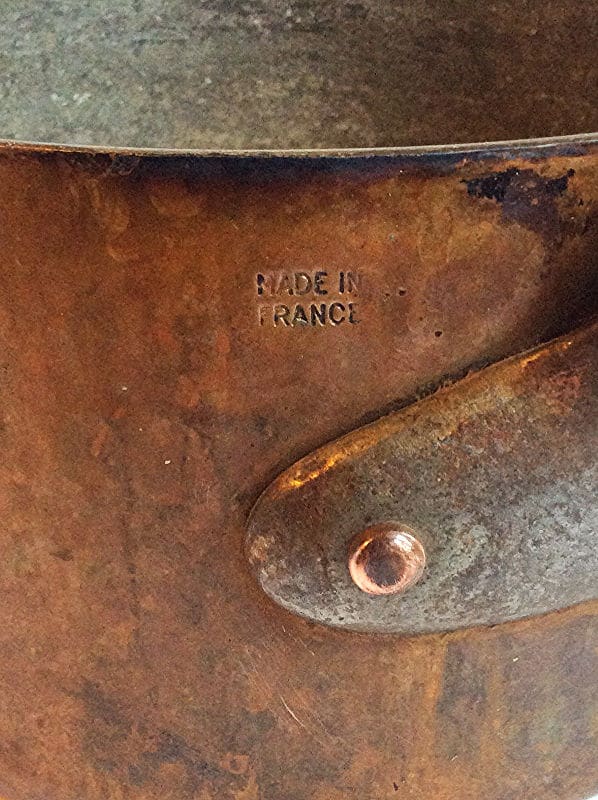
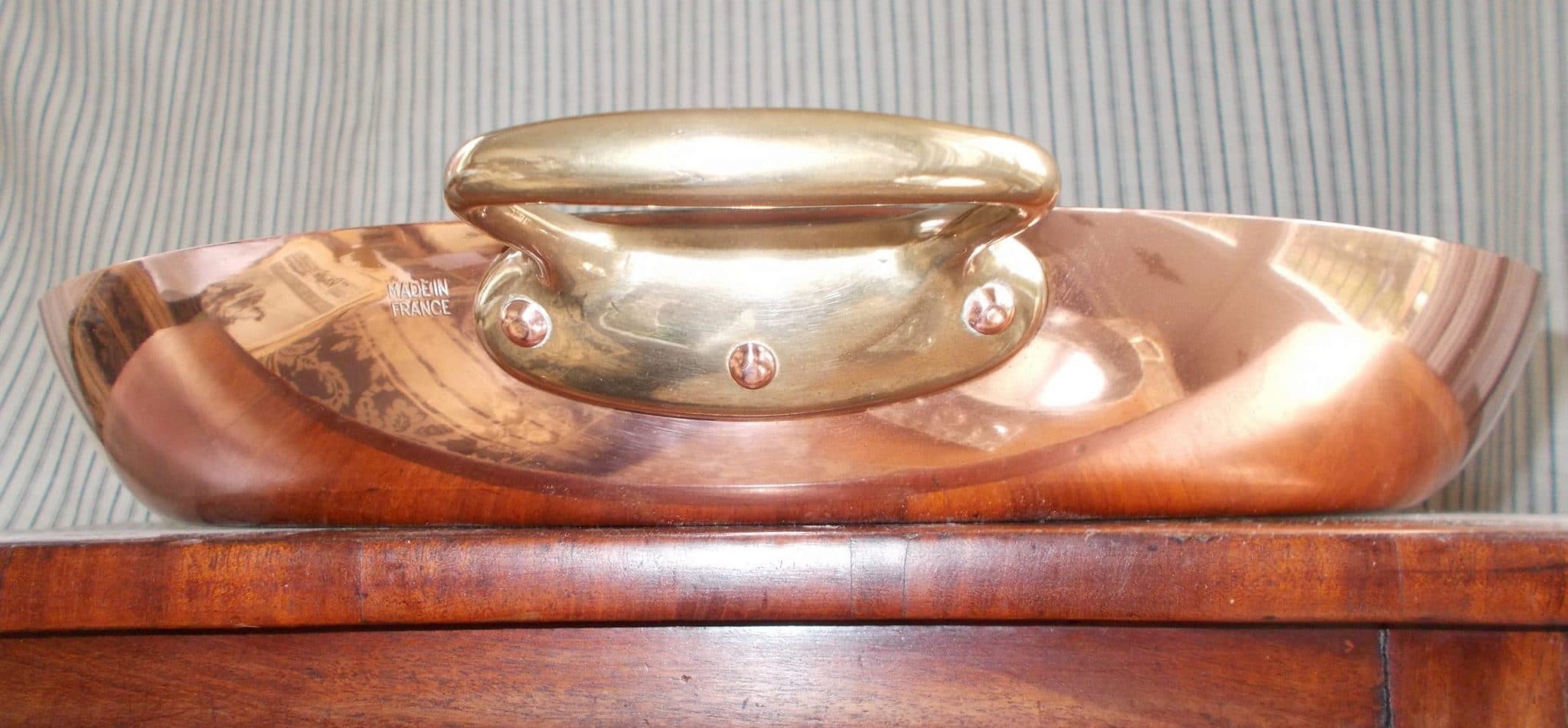

Three-line

This is a fairly rare stamp. It’s easy to distinguish from the others, of course, given its typographical layout.
Examples
With maker stamp
The examples I have of this stamp are accompanied by stamps for Atelier du Cuivre and Lecellier. I believe Lecellier operated its own factory, and perhaps Atelier du Cuivre sourced copper from them for a period of time.




Conclusions
As is usually the case when I dig into an issue like this, I answer some questions while coming away with new ones. You can of course draw your own conclusions from what I present above as well as from your own experience, but I offer these ideas.
- The one-line stamp is almost certainly a Villedieu product, but I don’t know which one. It could be Mauviel or one of the other Villedieu makers.
- The two-line oval-shaped stamp is pretty much a dead giveaway that the piece is Mauviel. This stamp is very distinctive once you know what to look for, so I am fairly confident in saying that whenever you see this stamp, it’s Mauviel.
- I’m not sure about the two-line “long M” stamp. My examples are stamped for Gaillard, but also generically for Villedieu. It may be that these were made by Mauviel (or Multiform, a machine shop in Villedieu), stamped, and then handed over for finishing.
- The two-line “short M” stamp is likely Mauviel or Atelier du Cuivre. The stamp can look different depending on whether it’s on a steel-lined or tin-lined piece. These pieces are likely identical in quality regardless of the maker’s mark.
- The three-line stamp is a Villedieu stamp. I suspect it was used by Lecellier, but I am looking for more information.
I welcome any information you can contribute — let me know in the comments or by email.
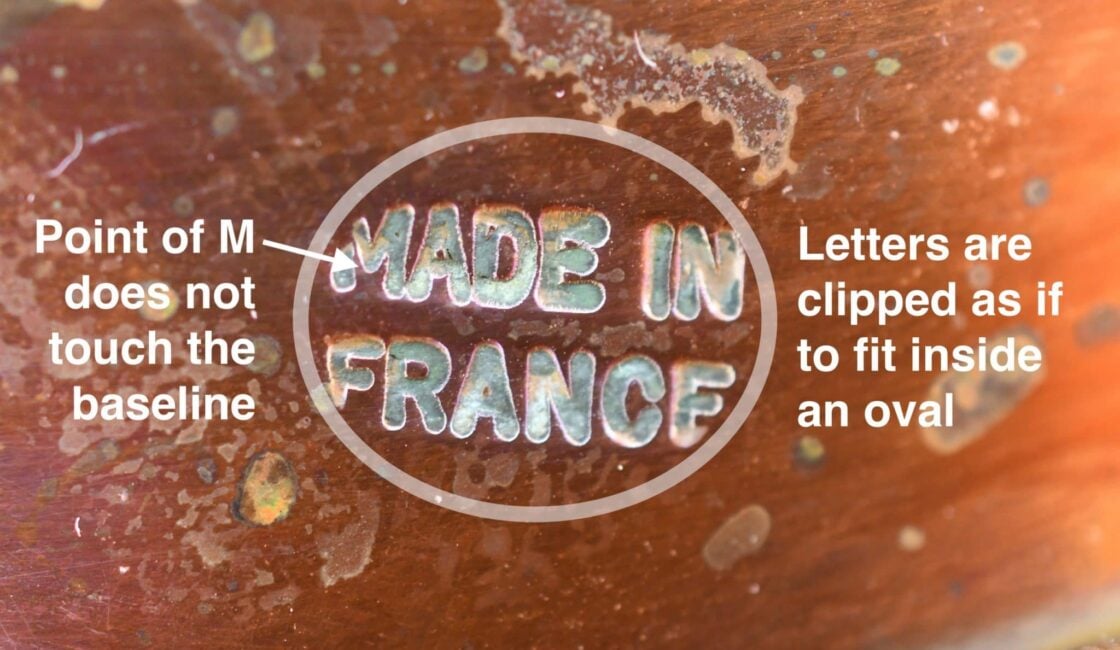
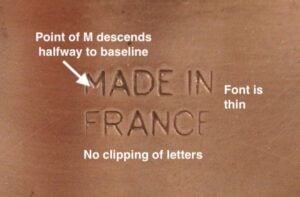
Hi, here is an example of the “long M” used on a Jacquotot 22cm saute pan. The pan came from a restaurant in Paris.
https://s1053.photobucket.com/user/swhalen10/media/001_zpsfoycdml7.jpg.html
https://s1053.photobucket.com/user/swhalen10/media/002_zpsyyhldcep.jpg.html
Please let me know if you can’t extract the photos like you did before.
Steve
Steve, thank you! I’ll add the photos to the section. I’m very curious as to whether this means Jacquotot survived into the 1960s, or whether this stamp was added to old stock. What do you think?
According to information I found on the site “French Kitchen Antiques” (https://frenchkitchenantiques.com/the-antique-copper-pans-of-j-jacquotot ) , in 1971 there remained just a small bit of the Jacquotot company at 77 Rue Damesme so it is very possible that this pan was made in the 1960’s and imprinted with the “MADE IN FRANCE” stamp. I wish there was a definitive history of these copperware producers and sellers available.
The question I have is, how many French makers actually *made* copper after WWII, as opposed to sourcing & re-stamping? I find it hard to believe that the elderly Jacquotot couple described in the French Kitchen Antiques post were operating a manufacturing concern. Were they buying from Mauviel and stamping their own name on it? Why didn’t they latch onto the US market like Mauviel did?
This makes me wonder if there was a dark side to the Williams-Sonoma revolution (for lack of a better term) — if the US retail appetite for copper favored reliably high-volume producers, small houses that could not commit to volume production missed out and dwindled. If Jacquotot and Gaillard fell to sourcing from Mauviel (or another Villedieu producer), re-stamping, and then re-selling via an additional retail outlet, they would have been an extraneous middleman — the stores could make more profit going directly to Mauviel (as they did). Without a factory, a brand-only French maker would be superfluous, effectively competing with retail outlets as opposed to providing a unique product.
This is just a crazy idea, of course, and I only wish I had some primary sources to explore it!
In the pictures above under the section Two-line, rectangular shape, long M — no maker or store stamp, the 3rd picture. Do you know anything about that pot? I have a stock pot with the same hammering, lid and mark work in the same place.
Hi Carl! I went back into that set of photos and added numbers to them to make sure we’re talking about the same thing. (Sheesh, there are a lot of photos in that one!) My quick guess on a pot with that look of hammering is that it’s Mauviel, but I’d have to look at the rest of the pot to be sure. Feel free to email me a photo if you like — vfc at vintagefrenchcopper dot com.
That’s the one, #3. The interesting part is the wear on the mark is exactly like mine. I’ll send you pictures later. Thanks for the response!
Steve, how old is this particular pan? Do you know how long this stamp was used? I’m trying to date a Jacquotot saucepan with this exact stamping. Thank you.
William, if you are referring to the Rue Damesme address I am not sure exactly when Jacquotot switched from the Rue Grenelle stamp to the Rue Damesme one. Jacquotot resided at both those addresses since the 1930’s so when they switched stamps on their pans is open to conjecture. From the description of the shop visited by the Cuisinart executive around 1970 it seems at that time Jacquotot was only a shell of its former self and I have to wonder if they were even producing new pans for sale.
That’s been my question too. Jacquotot, like Gaillard, seems to have been a restaurant supply enterprise with more items than just copper cookware. Could they have subsisted for a while as a wholesaler? Could they have stamped their name on other makers’ copper, like a retailer? I wish I knew more about the Rue Damesme location and for how long it was actively making copper.
As the pan illustrated has the “Made In France” stamp, according to research by VFC the pan was made some time after 1957 till the time Jacquotot stopped offering new pans for sale.
And as always, I feel compelled to point out that 1957 is an approximation on my part. Every copper seller I’ve asked says that “Made in France” started showing up in the 1960s; the EEC, founded 1957, imposed country-of-origin labeling requirements on member states and I’ve assumed that was the precipitating event for the addition of the stamp to French goods. If so, 1957 is the *earliest* that “Made in France” could have shown up, but realistically it could have taken a couple of years for the makers to come into compliance.
Based on VFC’s field guide for Jacquotot, the full time range could be from around 1960 (or 1957) to 1990. I was just wondering if you knew the provenance of your particular Rue Damesme that came from a Paris restaurant. As VFC commented just now, I, too, wonder if they stamped their name on other makers’ copper during this period. The truth is that they’re all beautiful to my eye, but knowing this would help appraise a future purchase. Thank you both for responding on a holiday. I hope everyone is safe. What a great community this is.
As Steve points out, the date of the transition from Rue de Grenelle to Rue Damesme is unclear. He says the company had the 77 Rue Damesme address in the 1930s but used Rue de Grenelle as the storefront (and stamp). I don’t know when and why they moved. I theorize in the field guide that it may have been around 1955 when Jean-Baptiste passed away and his son Alfred took over, but that is a guess. As always, I really welcome better information on this so I can make this site more accurate! (Reminds me I need to go look at that guide again and update it…)
And I echo your gratitude for the community of copper lovers. Whether you choose to comment, email me privately, or just read and learn, you’re helping to build a healthy vintage copper market and that is a great thing. Thank you.
William, when I purchased this pan from a French seller (actually a pair of these wonderful 22cm sautes) I asked if they knew what CONTI referred to and I was told they came from the Conti restaurant in Paris. That is all the information I was given
Hi V.,
do you know when/why Mauviel started using “Villedieu France” rather than “Made in France” on pieces they made for other companies? I have a pan that I guess was made as a promotional item/employee bonus or the like for a gastronomy wholesaler. It’s absolutely identical in design, dimensions and weight to the one Mauviel is still selling so it must be manufactured by them.
Hey Peter! I know the stamp of which you speak, and I’ve seen it alongside the Williams-Sonoma stamp and other store stamps that sourced from Mauviel so I also believe it’s a Mauviel mark. My guess at this moment is that this stamp is from the 1960s to early 1980s before Mauviel adopted the “Mauviel” branding and stamp in the mid-1980s. It seems possible to me that this stamp was the company’s first efforts to move away from the generic “Made in France” to the more specific “Villedieu France” (and the oval “Mauviel Villedieu”) prior to introducing the full Mauviel branding. Another possibility is that the three stamps represented different distribution channels (perhaps US, EU, and local Villedieu shops?) but that is just a hypothesis. What do you think? Does your piece feel like it could be 1960s-1980s?
No, it looks fairly recent actually, although I also have two sauce pans with similar branding which are 3 mm which I guess haven’t been in production for a while. So based on that and the company they were made for I would guess early ’90s at the earliest.
Hi, I have a pan, double handled with France stamped on either side and looks like Tourino as the maker. Any ideas of history?
Hey Yvonne — Could the stamp be “Tournus”?
Yes that is it! I can see the ‘us’ at the end of the stamps on one side. Any idea of history? Thank you.
Yvonne, the best history is on the Tournus site at https://www.tournus.com/lentreprise/depuis-1910/. Tournus started out in 1910 working with just aluminum but added more products. They didn’t make tinned copper that I can see, so your pot is most likely lined with aluminum or nickel.
Thank you for your help!
Might you have any info on a saucepan stamped only with Fabrication Francaise? It is tin lined hammered copper.
Hi Gilbert — I believe the “Fabrication Francaise” stamp with the stylized shape of France is a Baumalu mark.
MADE IN FRANCE
Country of Origin Labeleing (CoOL): Ultimately, the EU does NOT regulate the designation of origin “MADE IN ….”, but the country that imports goods from the EU. So there is no uniform rule. For the USA, however, a designation of origin is mandatory with a few exceptions.
Official site of the French Customs
https://www.douane.gouv.fr/demarche/obtenir-une-information-sur-le-made-france-imf
Translation from French:
LEGAL FRAMEWORK
“According to Article 1§2 of the Agreement on Rules of Origin (Annex 1A of the Marrakesh Agreement of April 15, 1994 establishing the World Trade Organization – WTO), the regulations relating to the marking of origin must be based on non-preferential rules of origin. In the European Union (EU), these rules are defined in Articles 59 to 61 of the Union Customs Code (CDU) as well as in the delegated and implementing regulations of the CDU.
THE ESSENTIAL POINT: “As a reminder, no national or European provision requires the affixing of an origin marking on products imported or marketed in the EU, except for certain agricultural or food products. The affixing of an origin marking of the “MADE IN” type is therefore, in most cases, optional.
For more information, see the sheet on “Made in / Made in” origin marking.”
In addition to the above-mentioned reference from the website of the French customs authorities:
https://fr.wikipedia.org/wiki/Fabriqu%C3%A9_en_France
(Automatic translation from French)
“Fabriqué en France” or “MADE IN FRANCE” is a reference to manufactured products to inform the consumer of the place of manufacture. The alternative word “fabrication française” (French manufacturing) is sometimes found. This appellation responds to a fashion effect where French products called “made in France” are increasingly in demand while French industrial production slows down. In 2019, 59% of French people believe that the country of manufacture is an important criterion of choice when buying a product or service. This market is not only developing in France but is also attracting foreign capital and foreign markets. Indeed, the MIF is often interpreted by foreigners as “a guarantee of quality”, “a brand image”, “a know-how”, “French refinement”. Some sectors of French know-how, including luxury and gastronomy, are now world-renowned.
LEGAL DEVICES
There is no general obligation to specify the origin of the products for sale in France.
POLITICAL USE
Support for French production by political parties or personalities has intervened many times in political life, especially during election campaigns. Georges Marchais, candidate of the Communist Party in 1981, had made the “French Produce” his slogan12. Also a member of the Communist Party, Pierre Juquin is the author of French Produce: The Great Challenge, published in 1983. This book, as well as the positions of Georges Marchais, bear witness to the precocity of concerns for the local and French production of the Communist Party. This political theme was then taken up in the 1990s by the National Front, before being the subject of François Bayrou’s campaign for the2012 French presidential election. Subsequently, Arnaud Montebourg made “Made in France” his workhorse as Minister of Productive Recovery.”
MY PERSONAL STATEMENT
Because of this and many other researches, I had to correct my previous knowledge. But I suspect that much of what has been written here at VFC on this MIF topic is still valid. However, it seems to me that a revision of this chapter on VFC is necessary.
Great article (great sleuthing too).
In looking through your many photos I notice that on a certain number of stamps the bottom of left leg of the capital “A” in “MADE” overlaps the bottom of right leg of the M (and nearly does so with the left side of D). In other examples the three letters are clearly separate and distinct.
Does that correlate with what you know about the manufacturers?
I’ve a few pans, some tinned, a couple nickel lined, purchased in mostly forgotten Paris specialty shops between thirty and forty years ago.
Most are 2.5+mm and all have the overlap.
Other than one marked The Design Store and another Chomette Favor, I’m stumped as to makers and origin.
Does the overlap offer a clue?
Hi Mallory, and may I extend a special welcome to a fellow detail-oriented person! I see what you mean — in some stamps, the MA seem to run together. But there are many variables that affect a stamp’s appearance and so I’m not sure if this is a recognizable signature of one maker. Variations in the amount of force from one strike to the next make some stamps look faint and others quite deep, and stamps also wear out over time, softening the contours of the letters. I think your Design Store and Chomette pans are likely Mauviel; your nickel-lined pieces could be unstamped Mauviel Cupronil, but Lecellier also did nickeled pans as well called Cunilec. Enjoy them — 2.5mm copper is wonderful for cooking!
I really enjoyed this post when I first saw it.
I bought an older copper kettle recently that has the 3 line Made in France stamp on the bottom, and no other markings. The fellow I bought from mentioned that it was Mauviel. Since buying mine I’ve seen the same kettle in a few listings online with the same 3 line MiF stamp and in one case pictured with a Mauviel tag.
Whether or not it’s Mauviel is not an issue for me but I do hope you find this an interesting addition to your research…
Couple of examples…
https://www.worthpoint.com/worthopedia/mauviel-copper-france-3-tea-kettle-1881849421
https://www.blackrockgalleries.com/product/french-made-mauviel-copper-tea-kettle-152074.html
An almost identical kettle can be found in the Mauviel catalog 1988 – Large “Swan Neck” Kettle. Only the handle is shaped slightly differently.
In principle, however, you should always critically check the information provided by professional sellers. For me, placing a trademark next to a product would not be a reliable proof of its origin. It is advisable to look for further features that are characteristic of a manufacturer and a time.
I believe the “copper” Mauviel tea kettle is now obsolete and no longer offered for sale by them. They can still be found for sale on various sites but the ones I have seen are not solid copper but rather copper plated on steel.
Any more info on the 3 line “Made in France” with no makers mark?
Hi, I have what looks to be a copper bowl with the Made in France that looks like it was stamped in an oval as you describe, the point of the M does not go all the way to the line, also the pot is stamped with SLT Sur La Table like you show on a steel pot. Do you have any information you could share with me about this?
Hey Anna! The Contact Me page has a way to send me photos — I’d be happy to take a look!
What does the number 3 represent on the inside rivets of a 12.5 inch brass handled copper bottom saute pan? Each rivet has a number 3 etched into it. Thanks!
Hi Kristian! At the moment I believe this is some kind of size marking for the rivet.